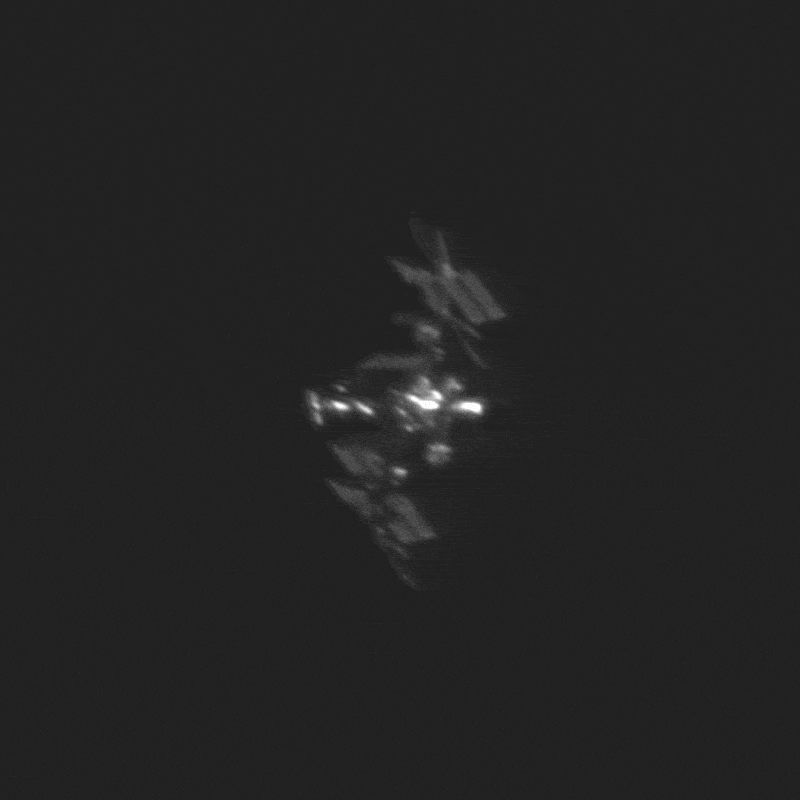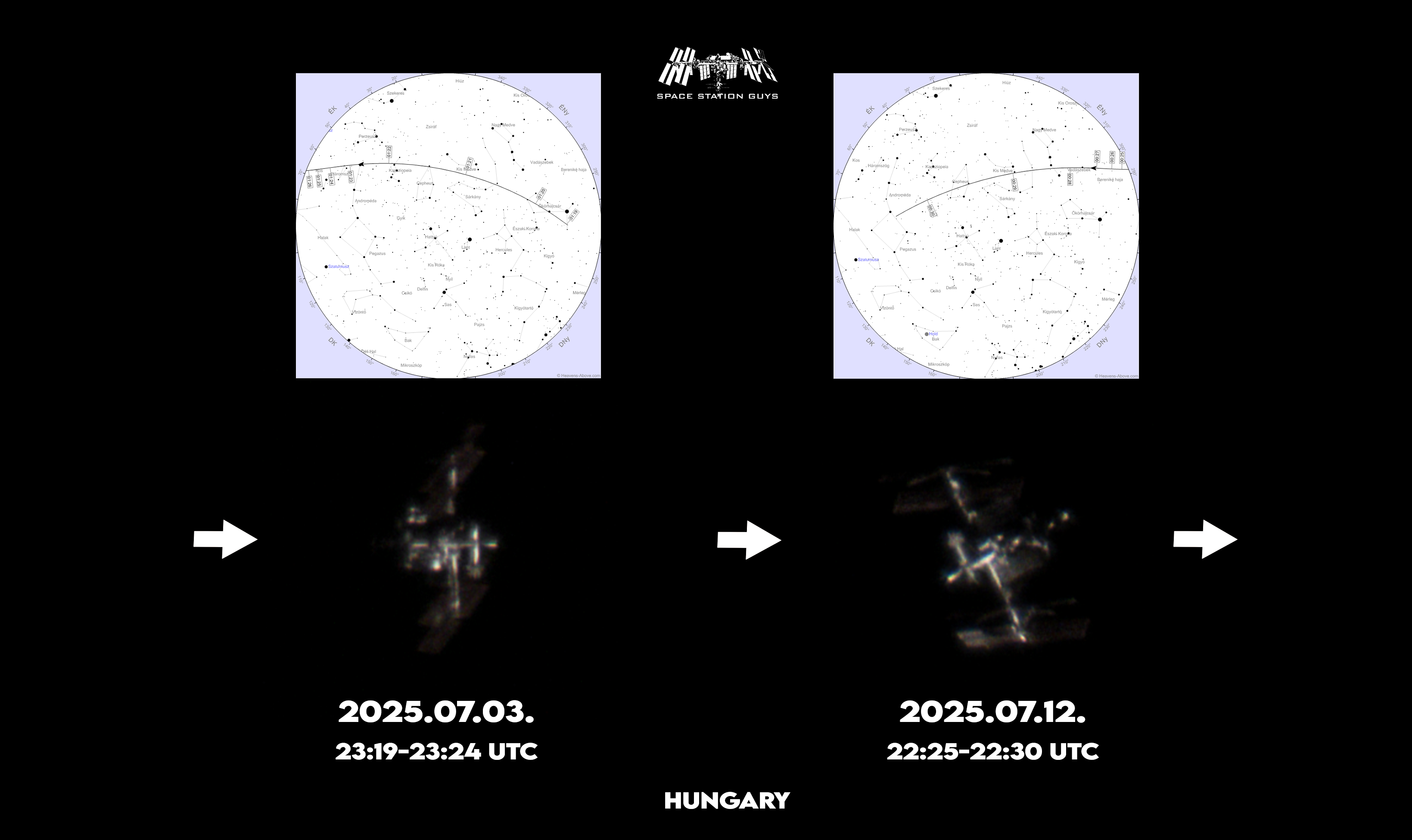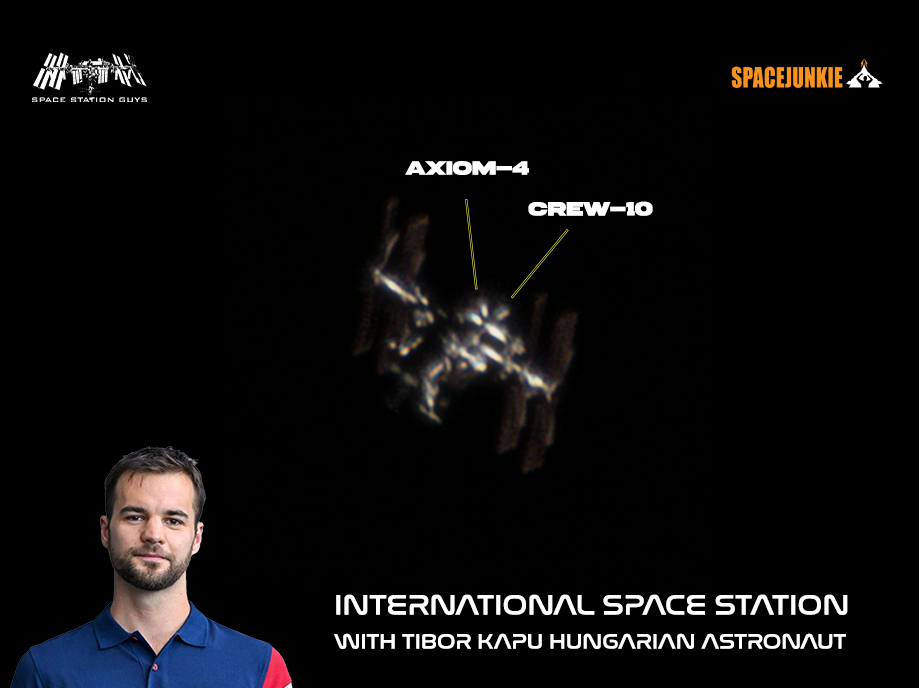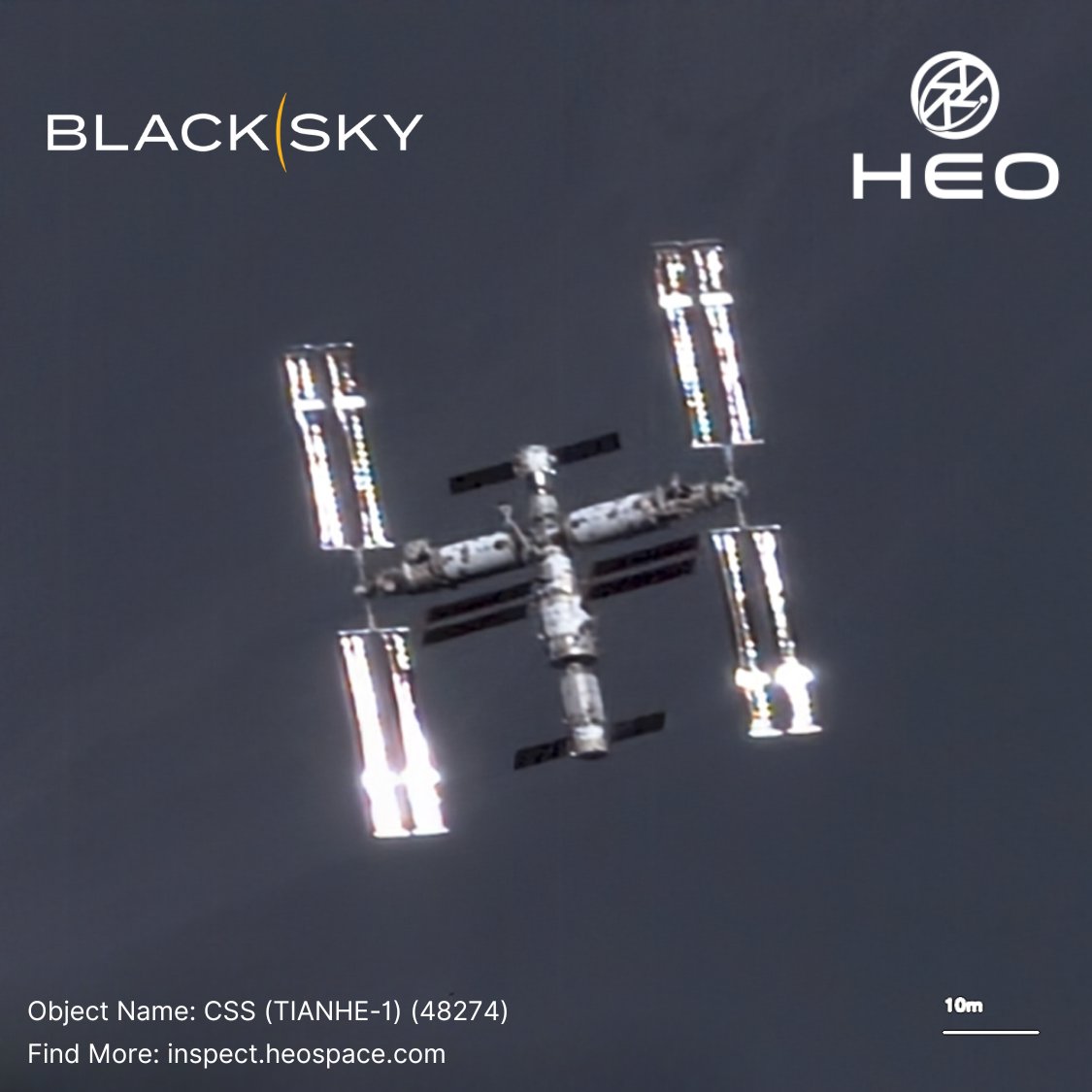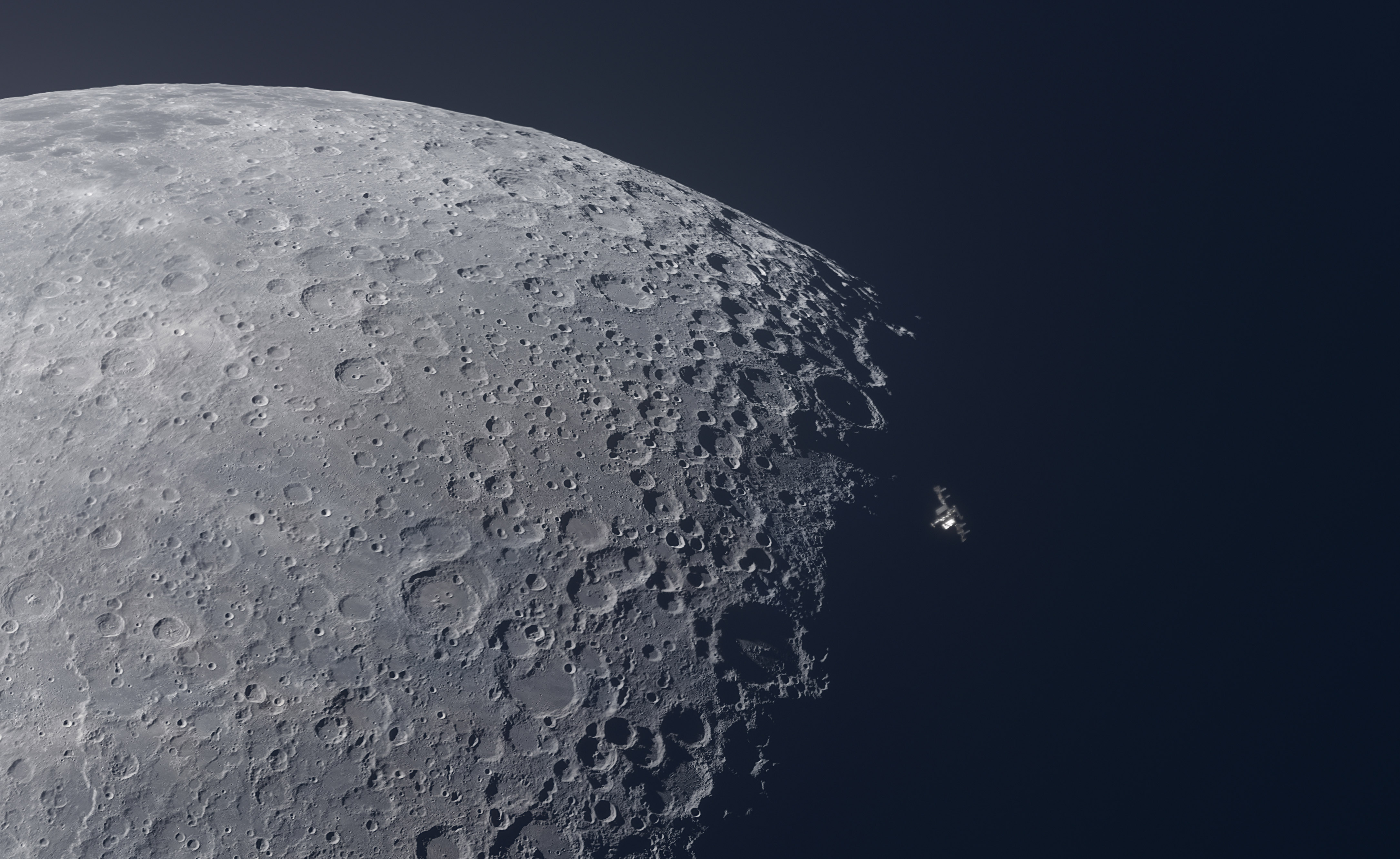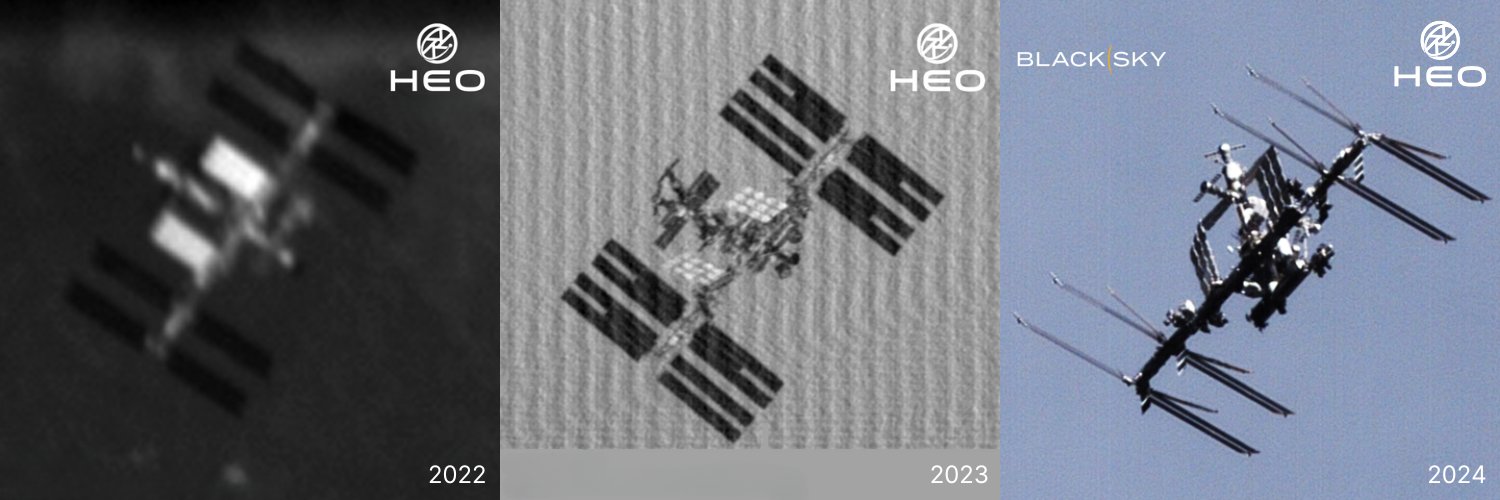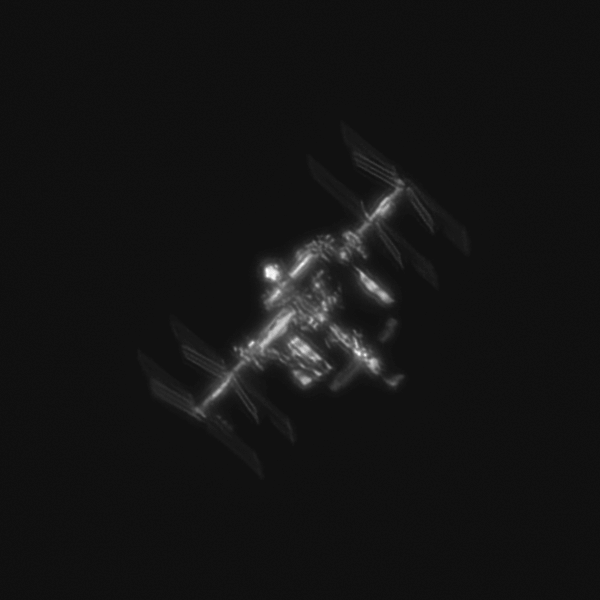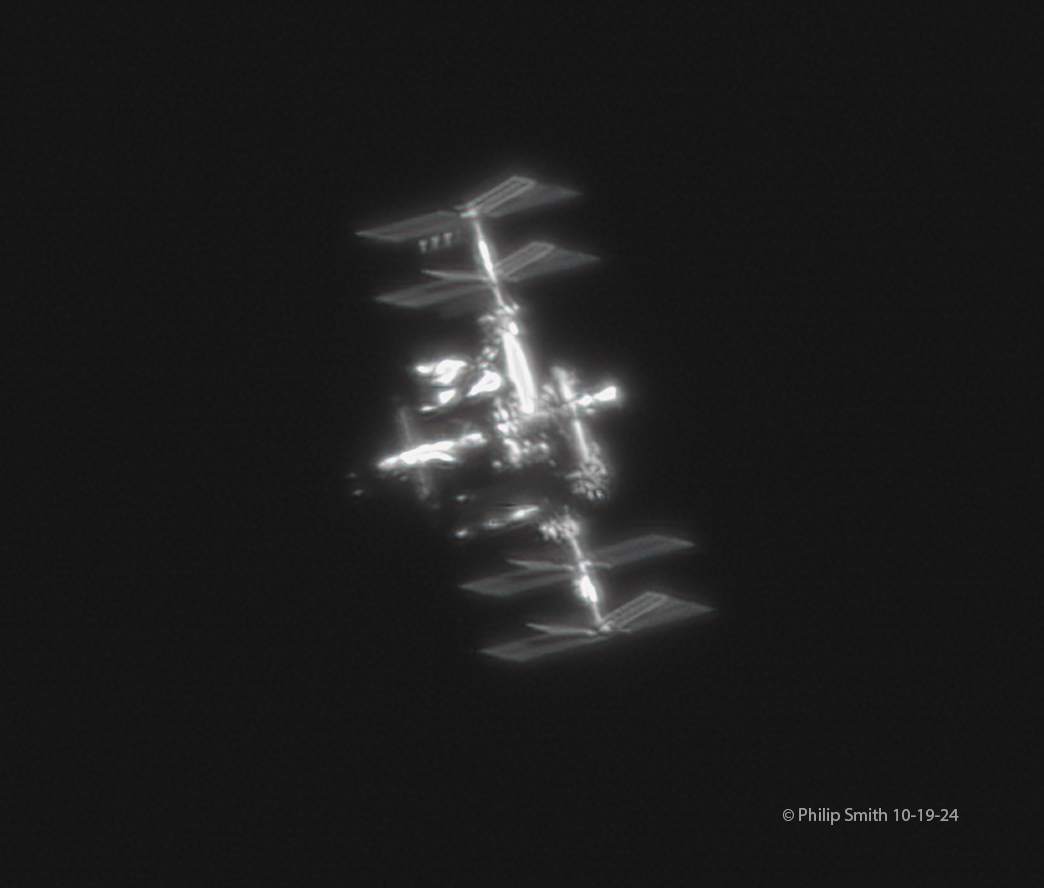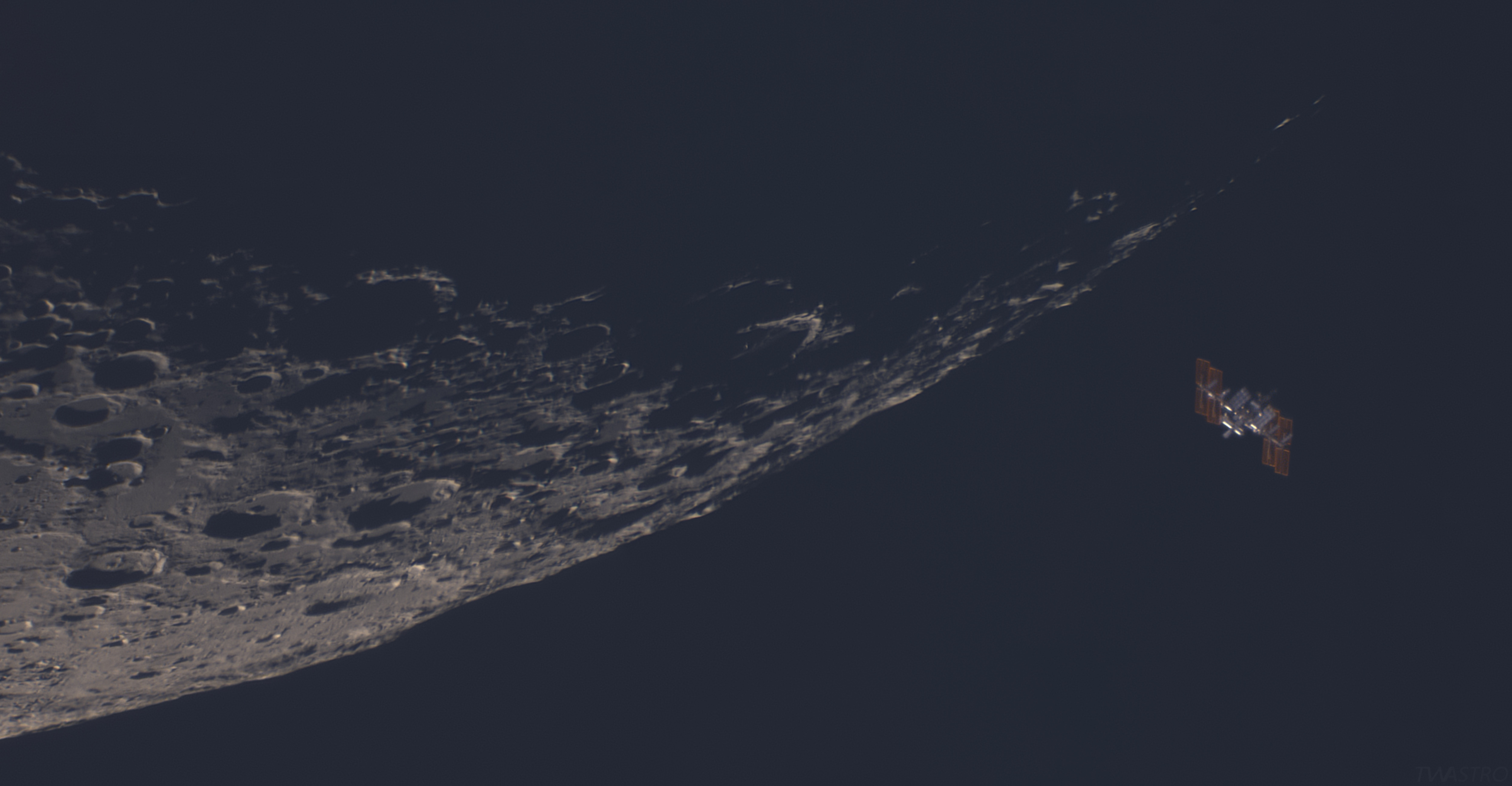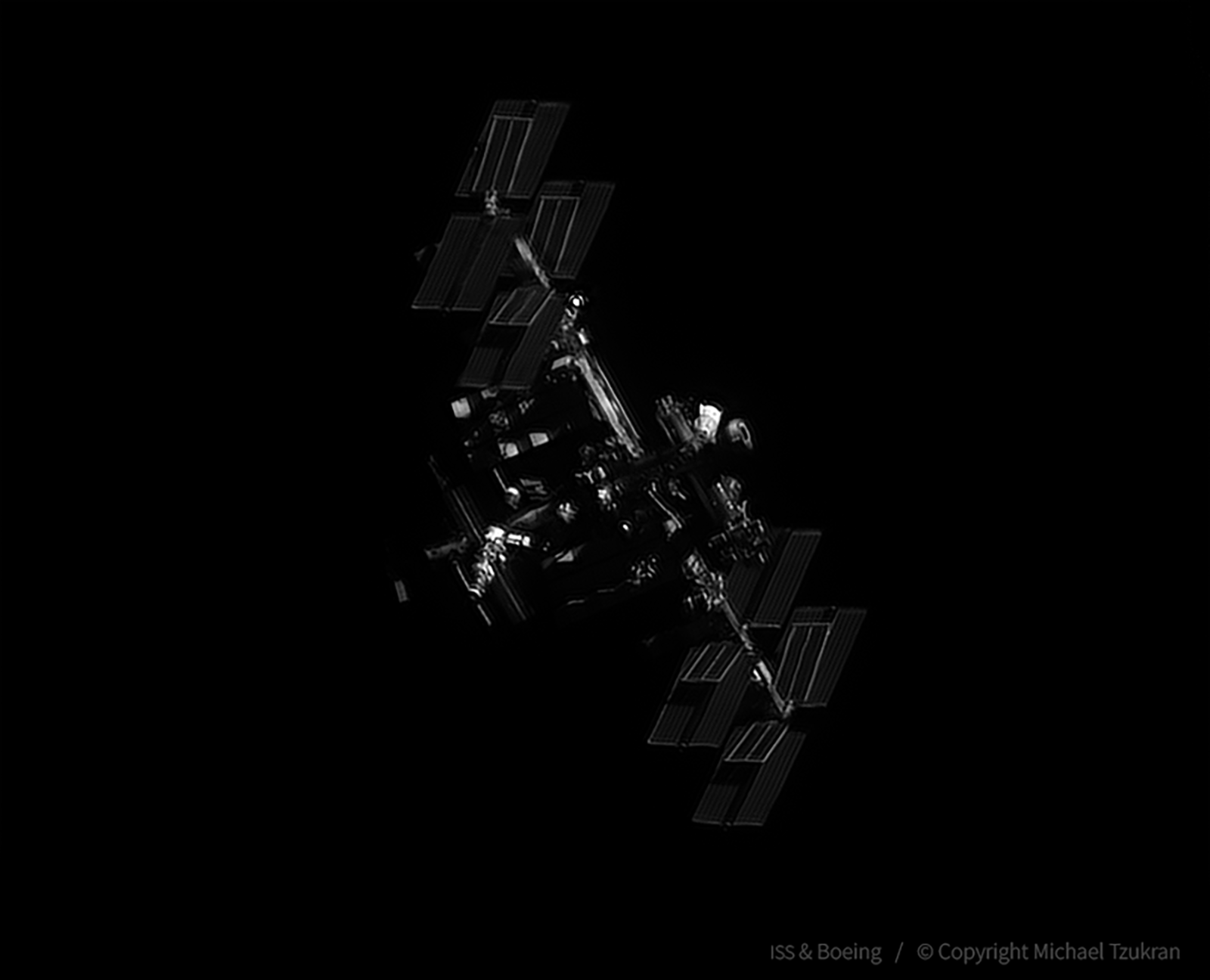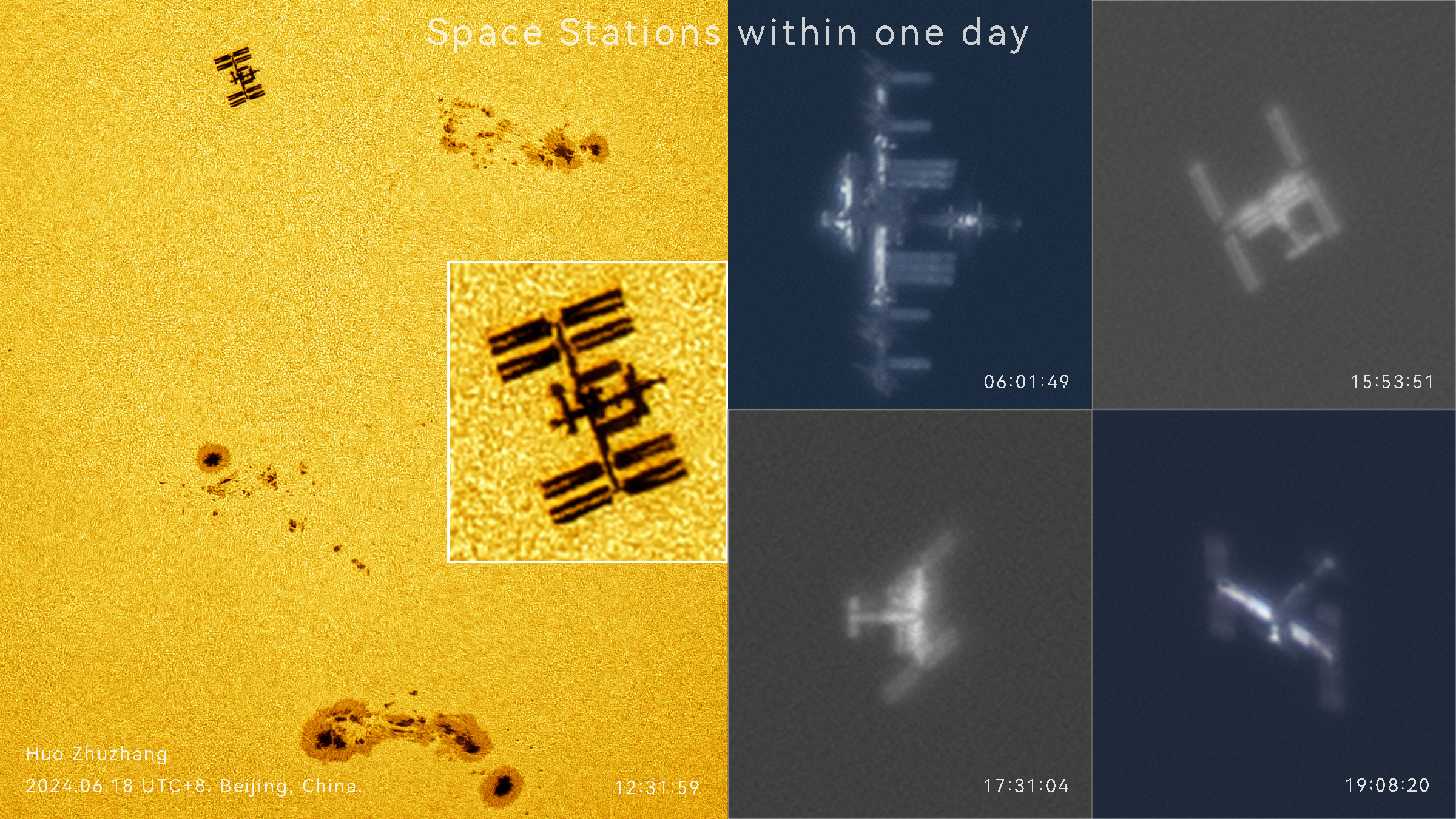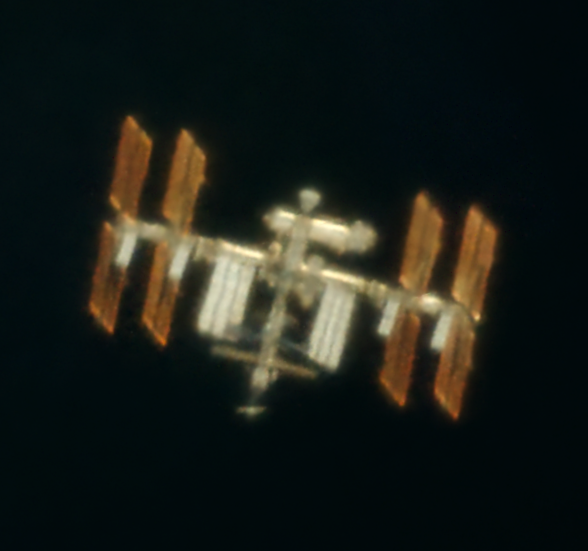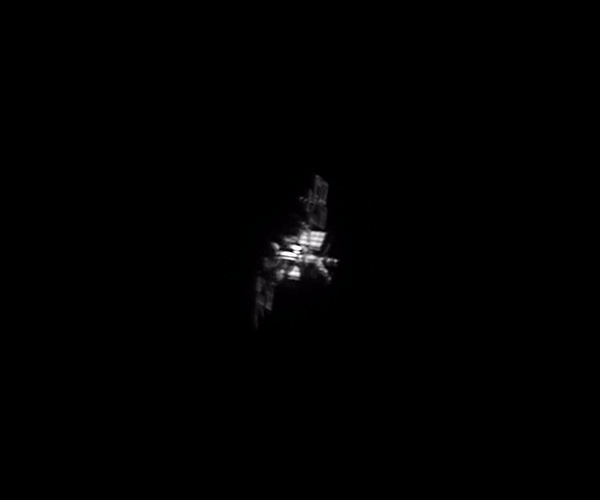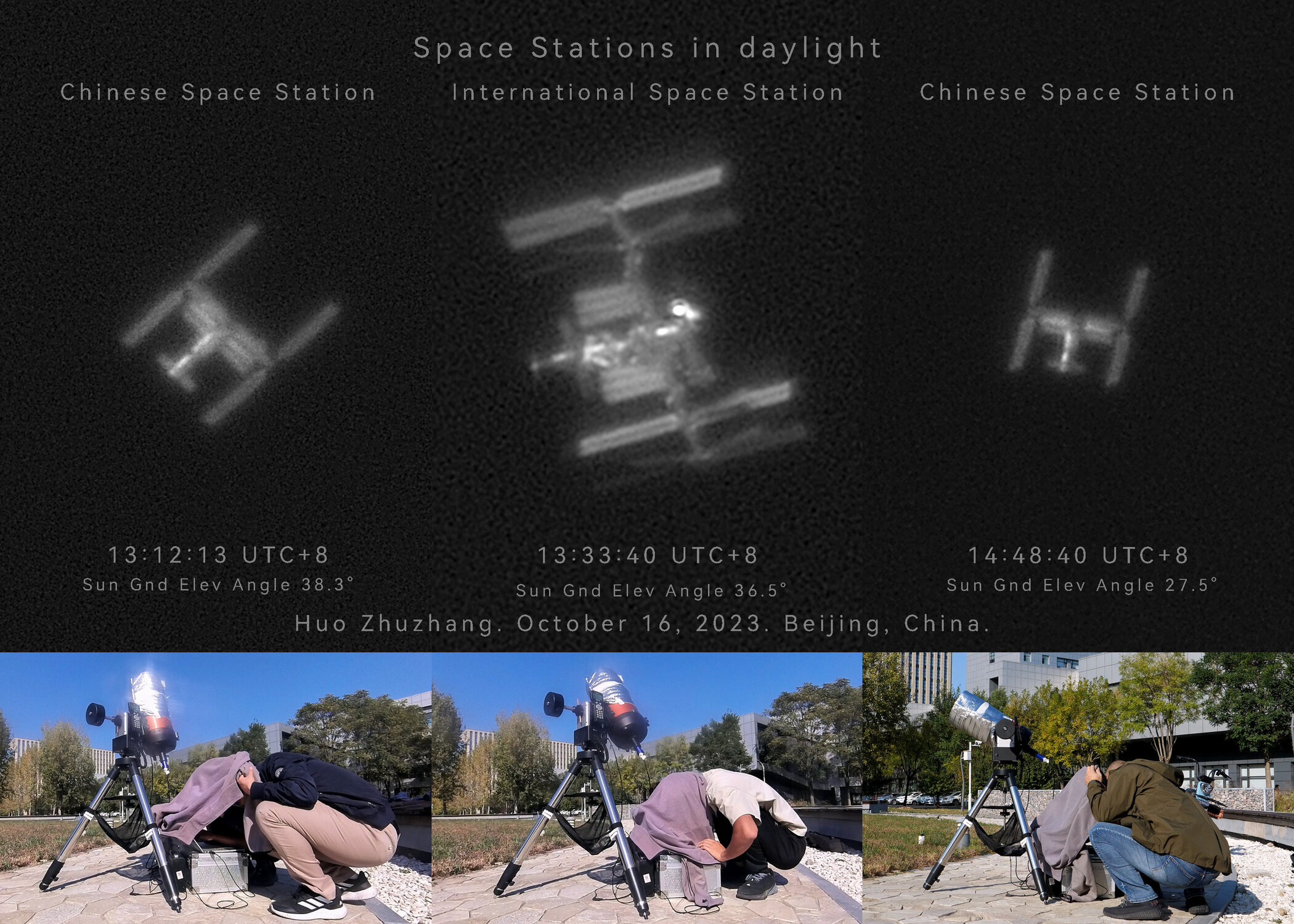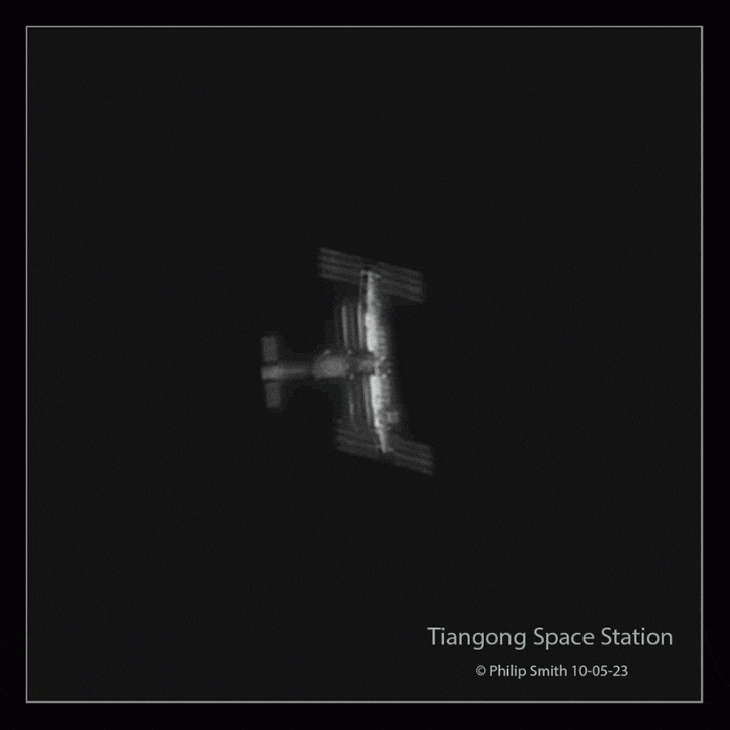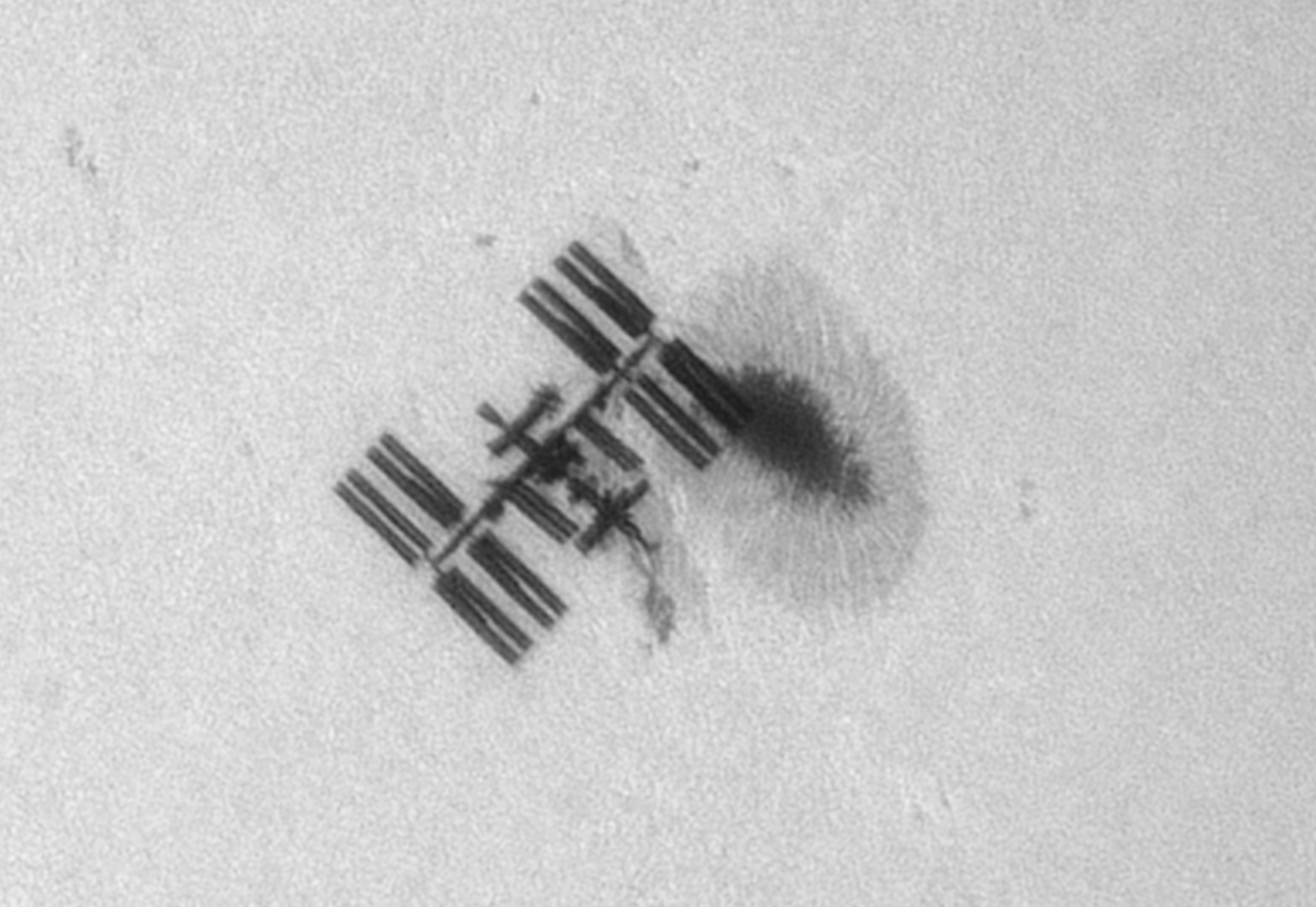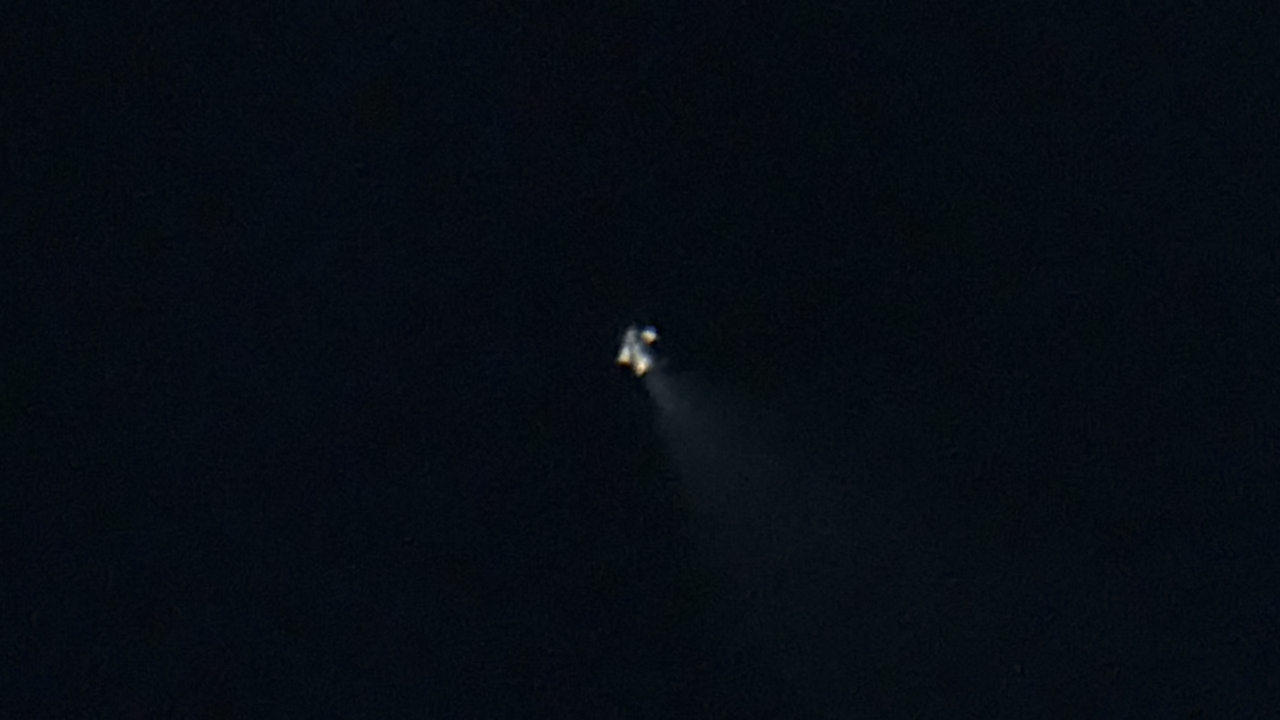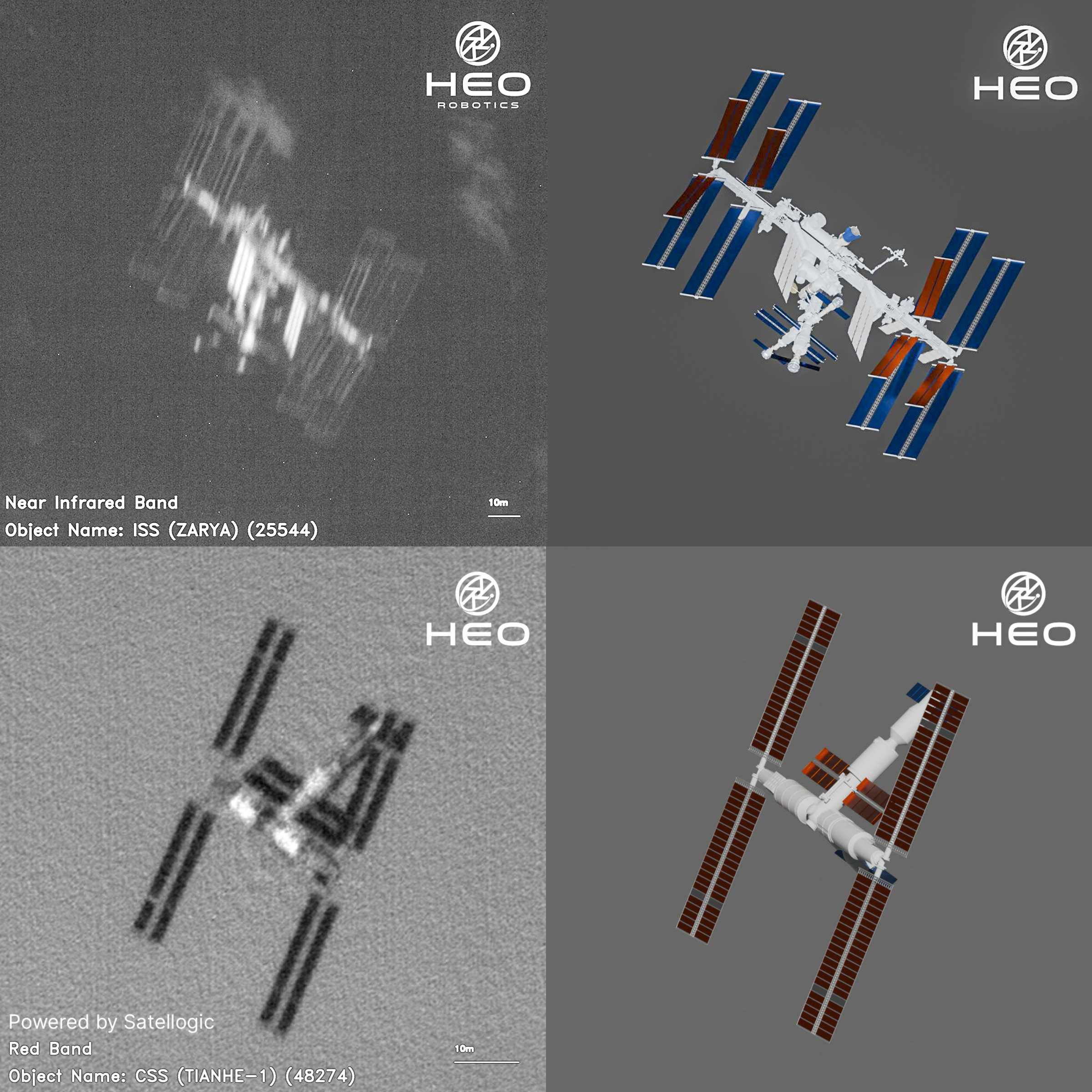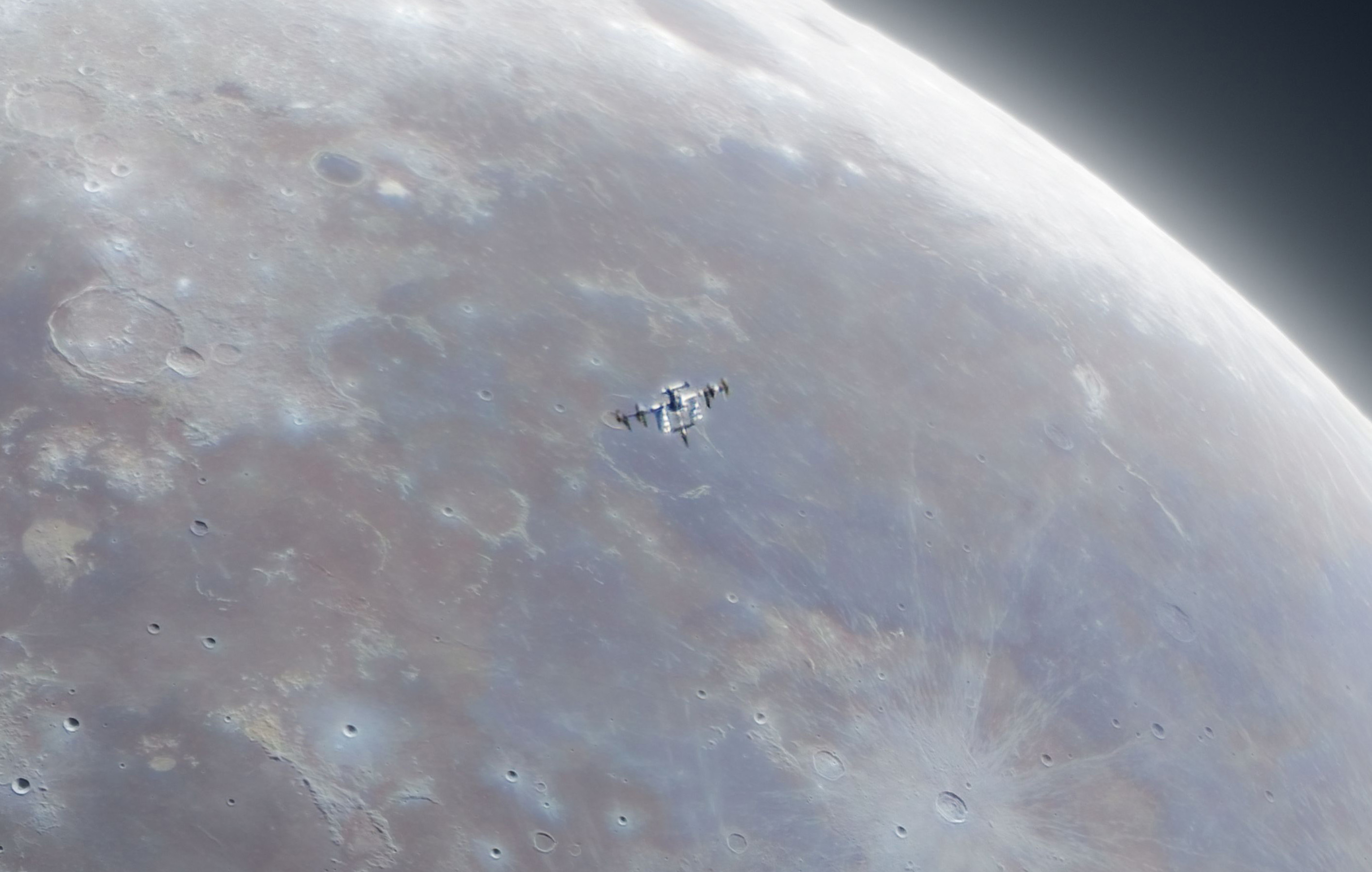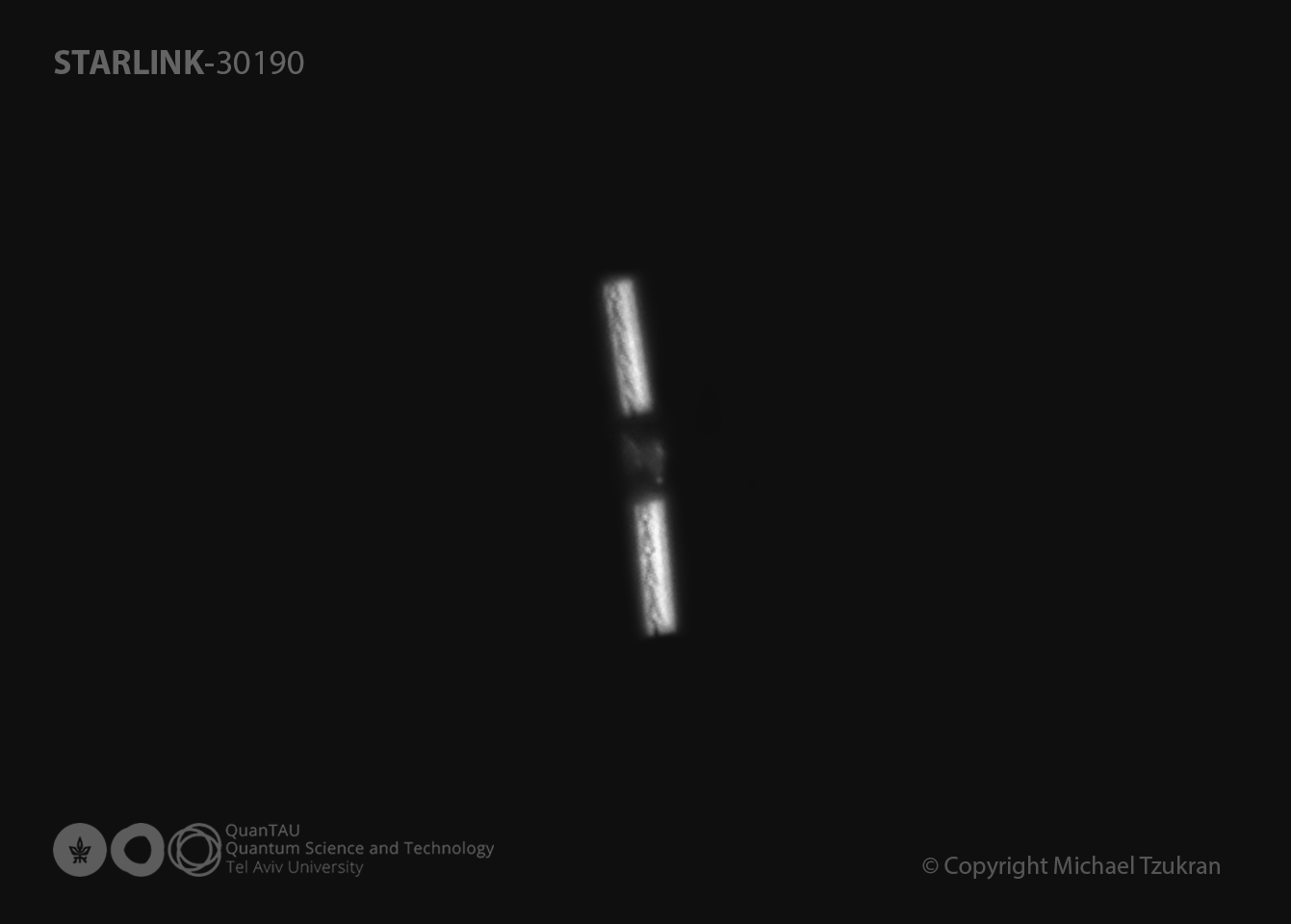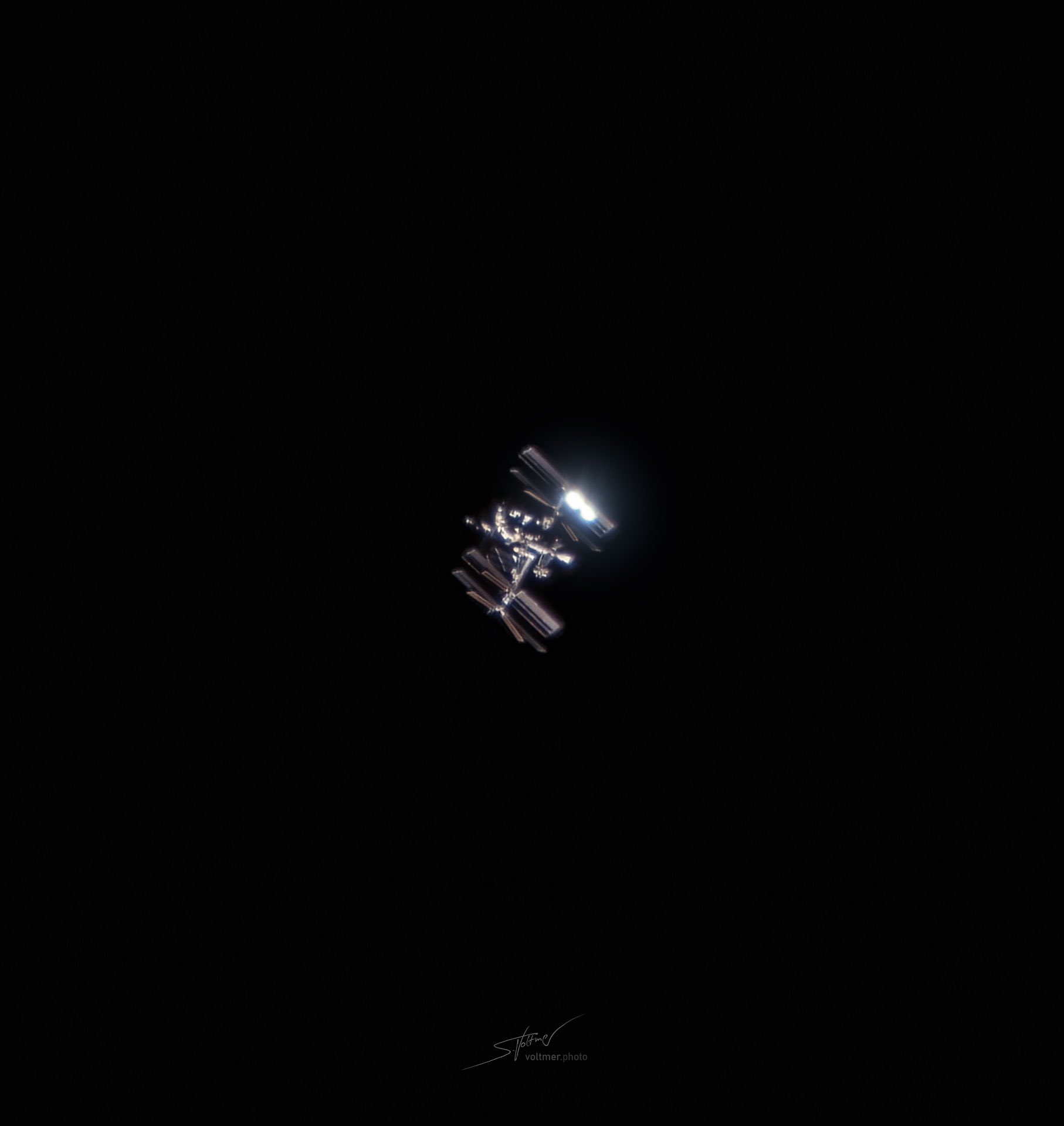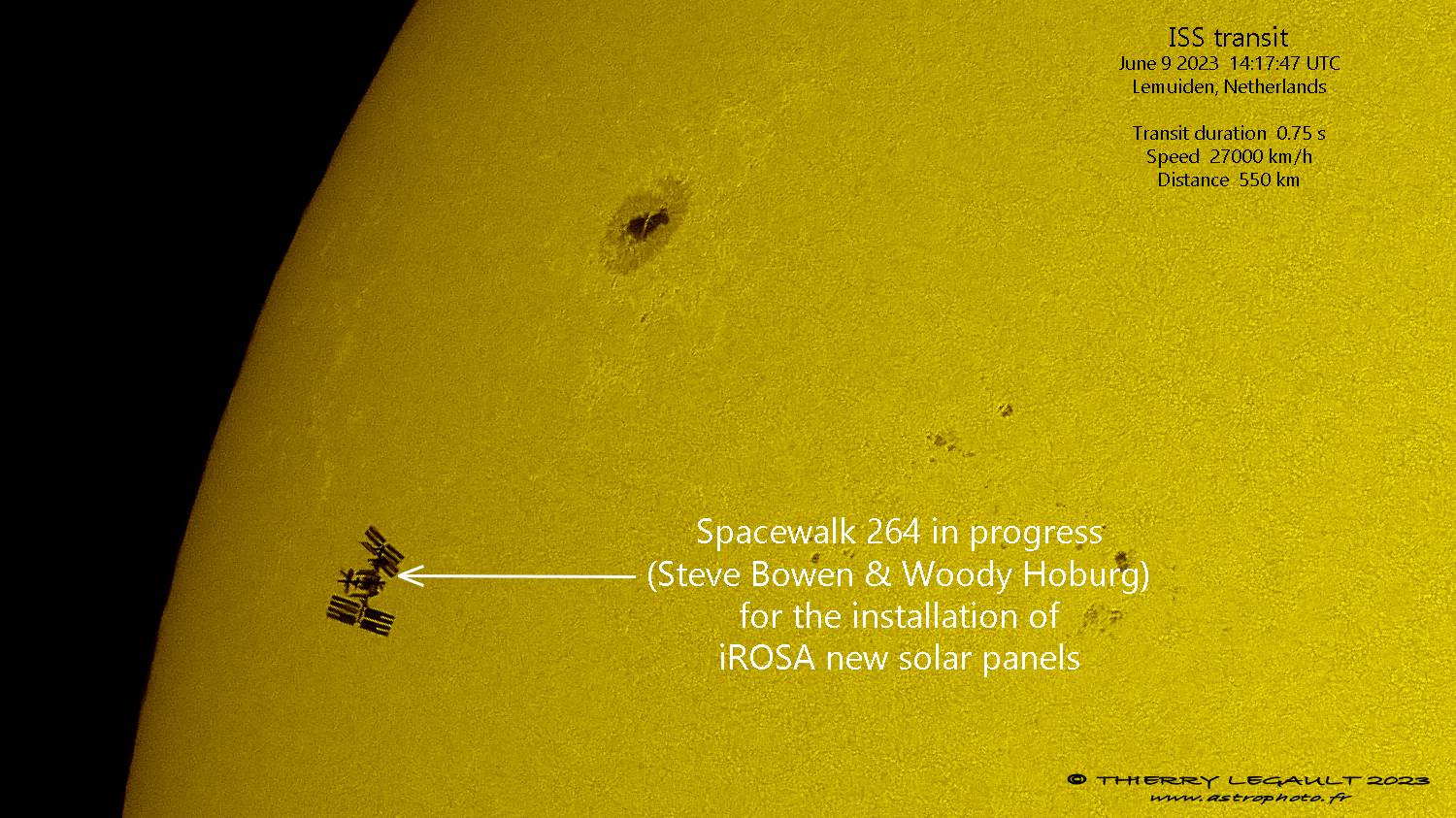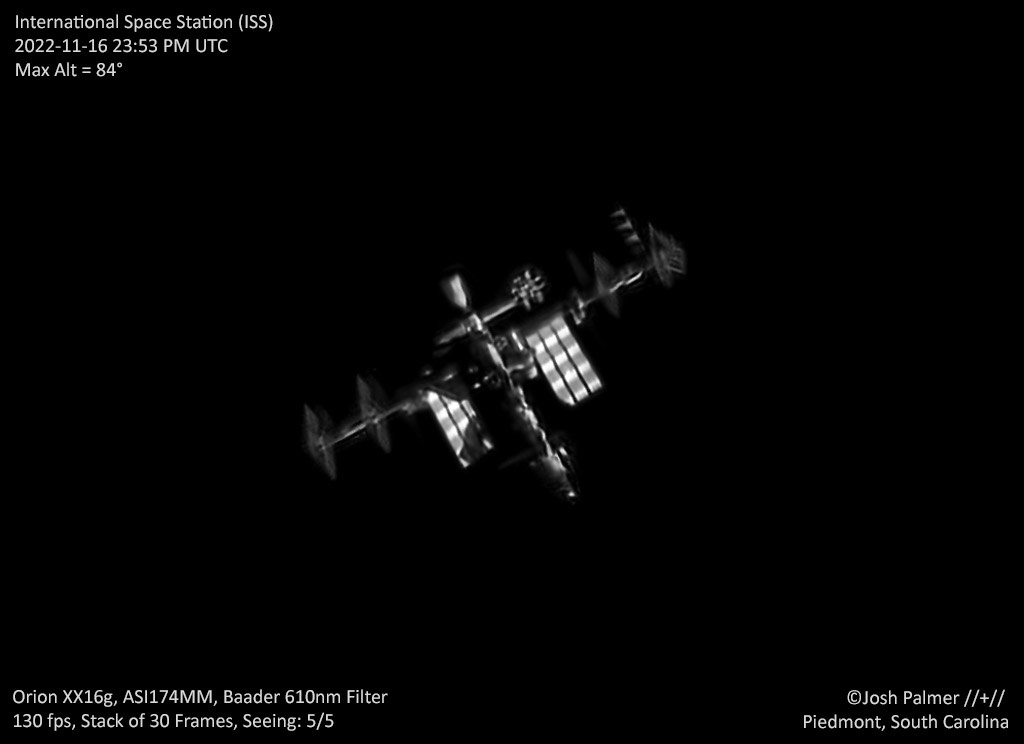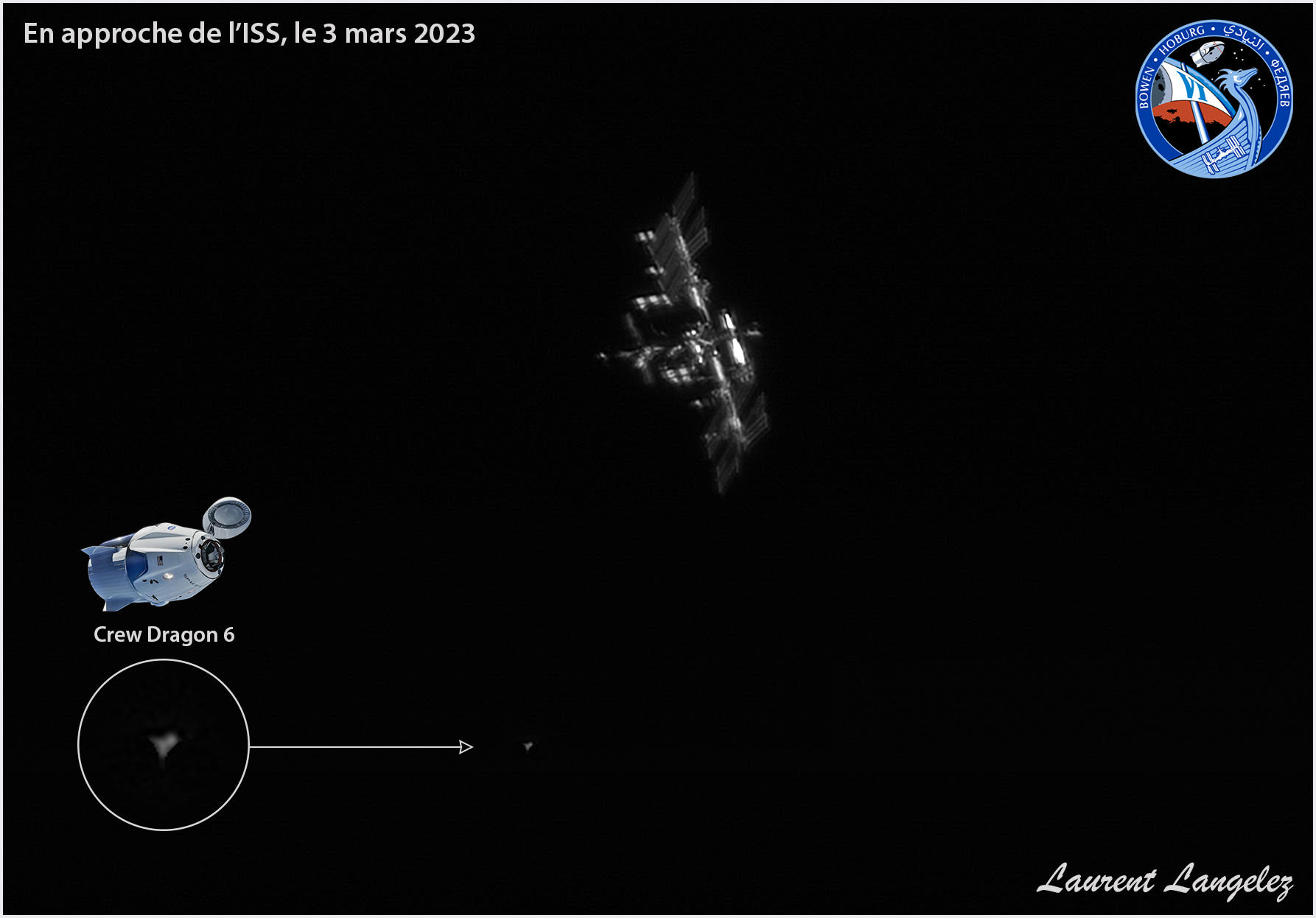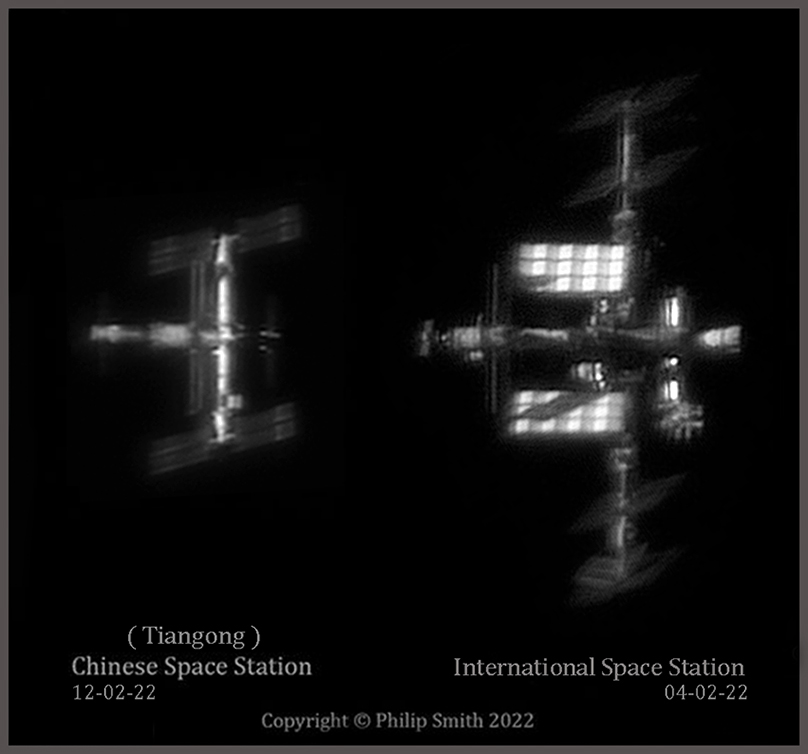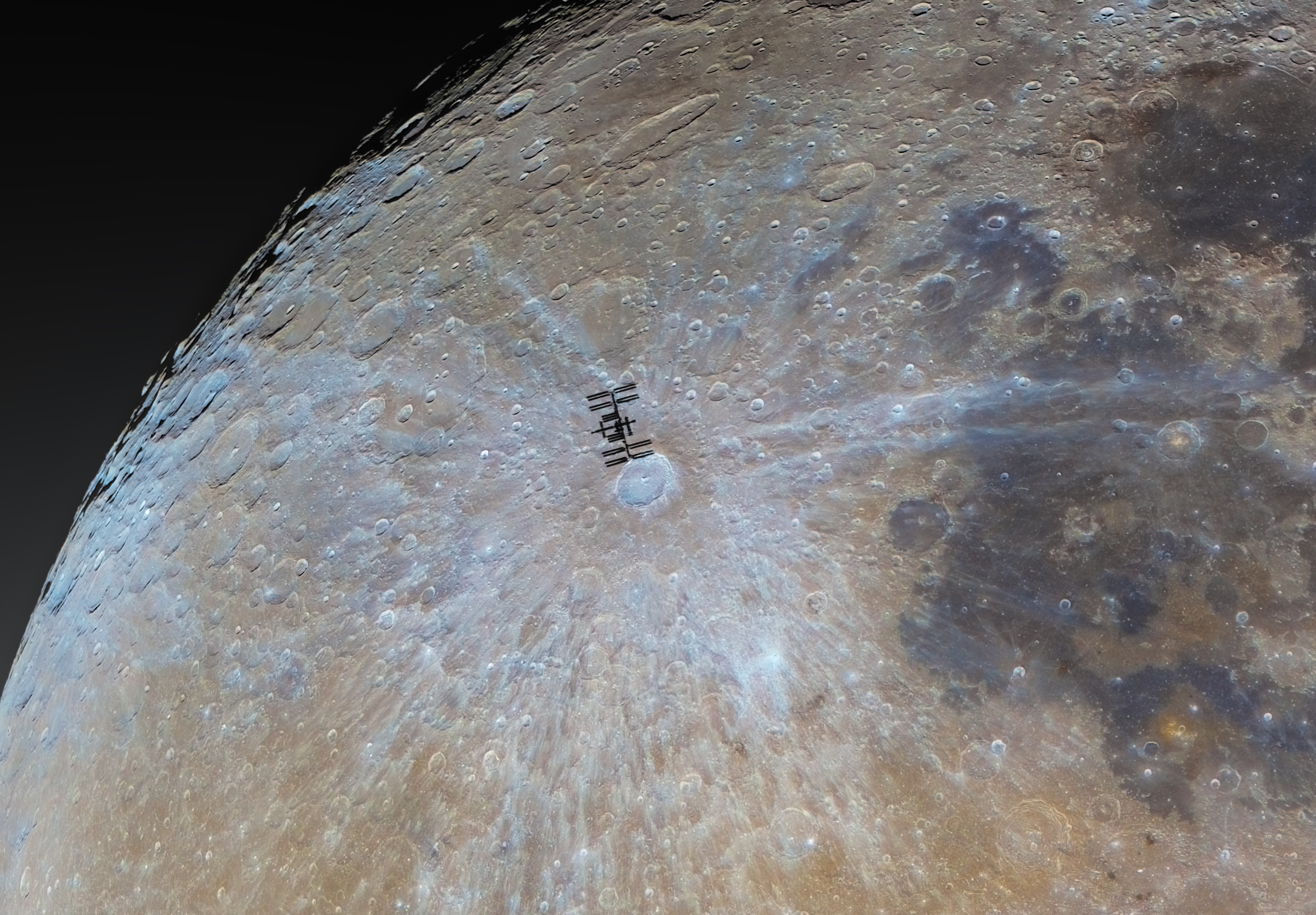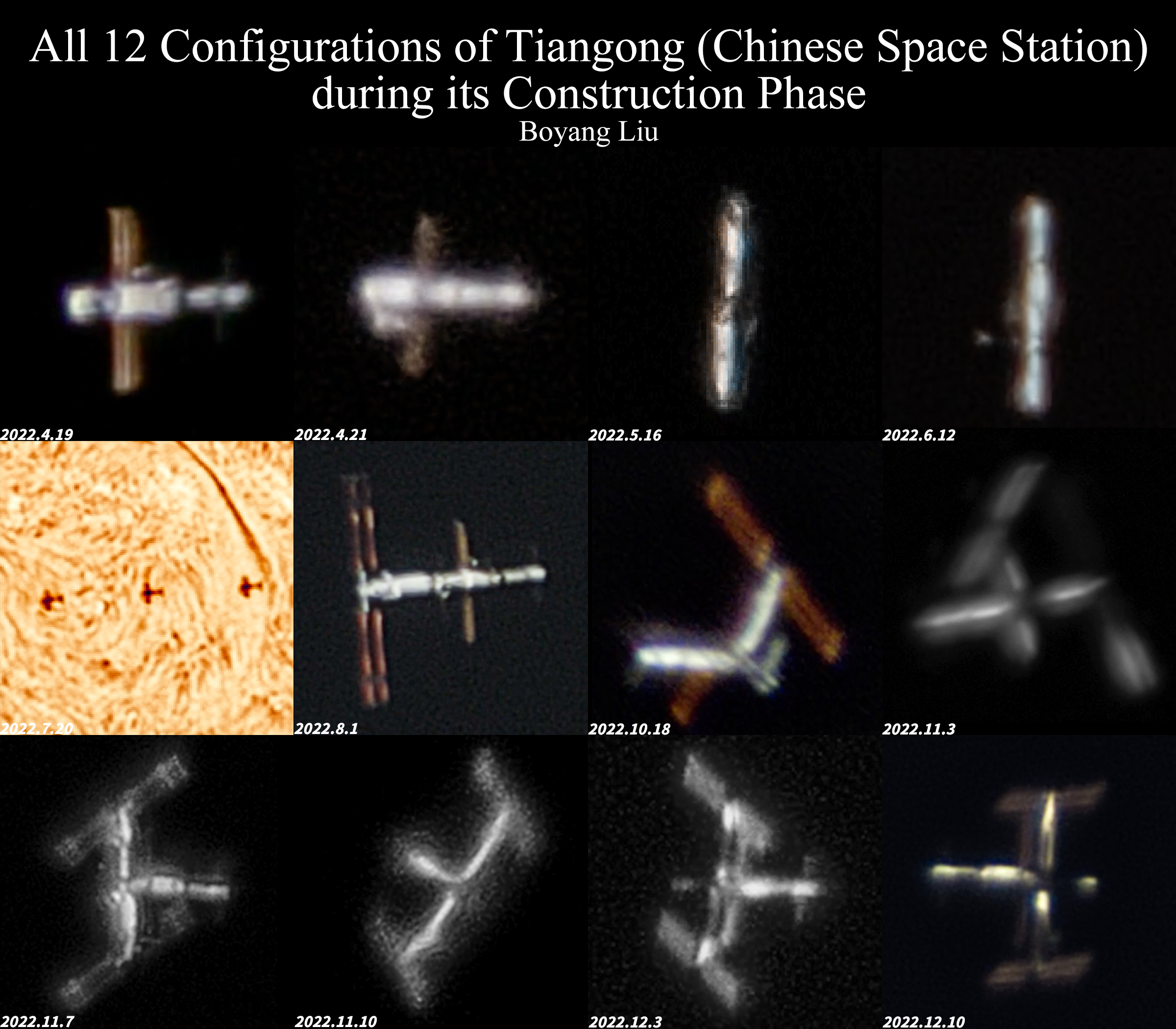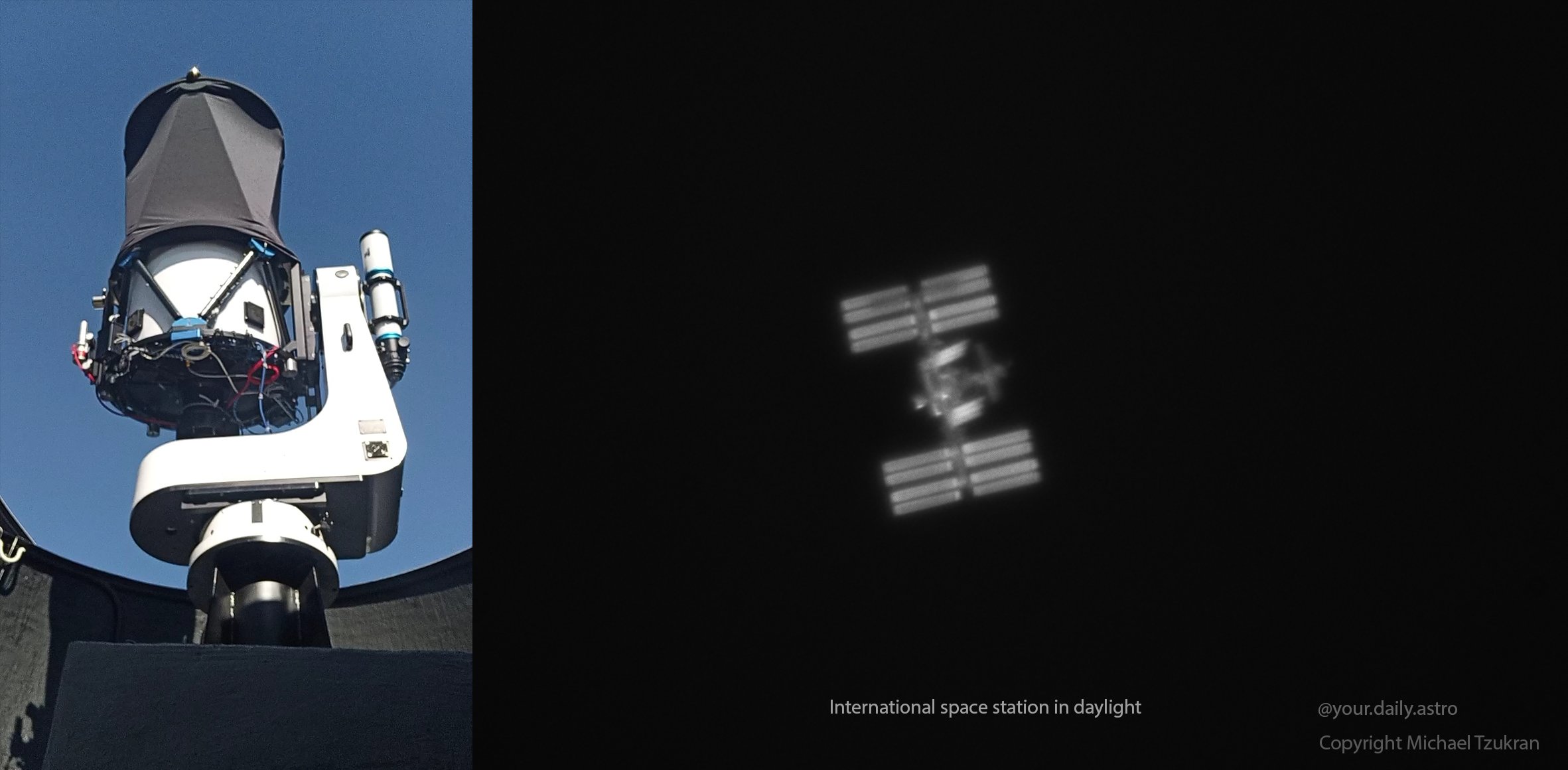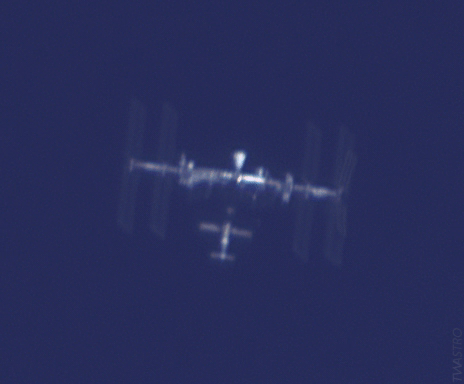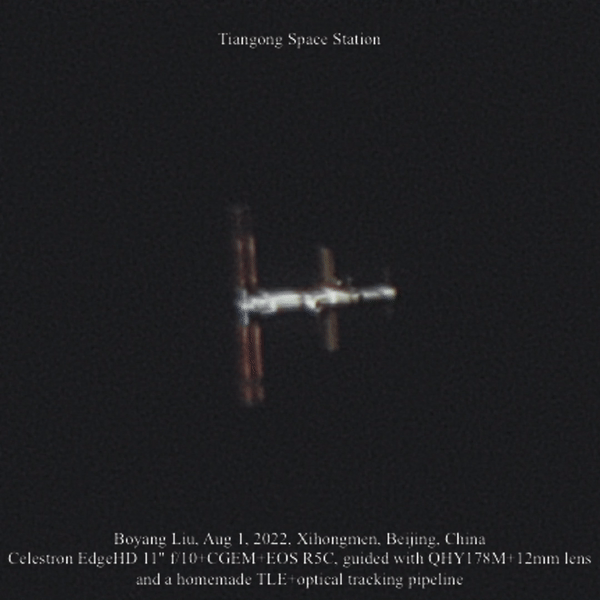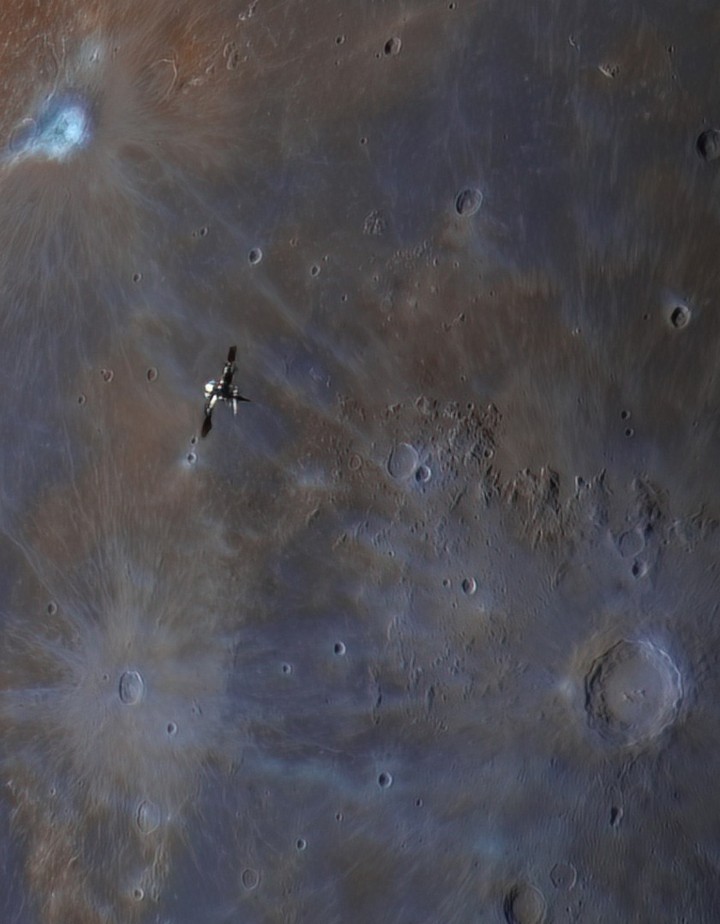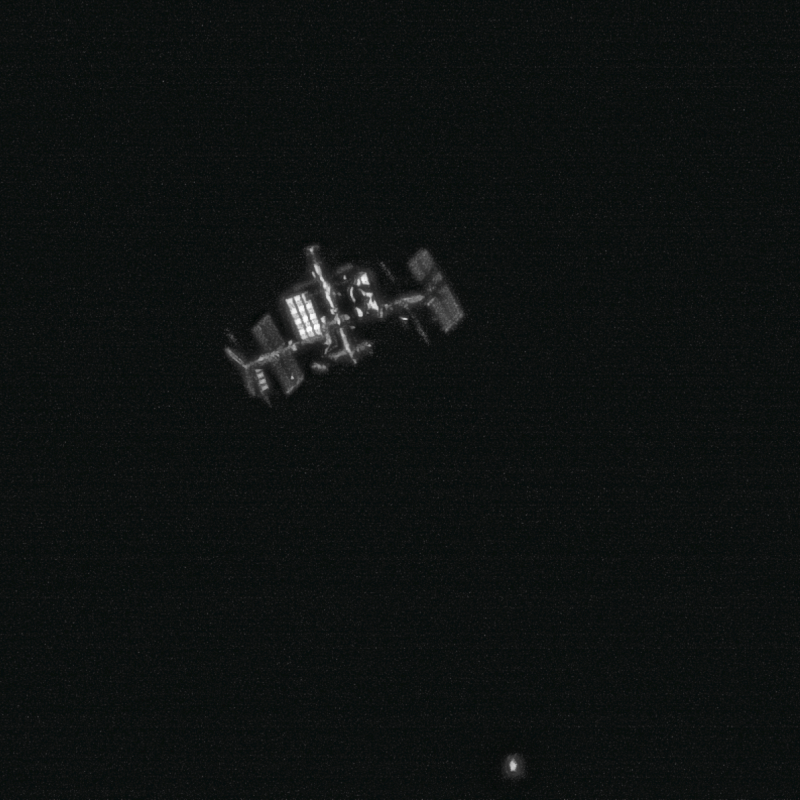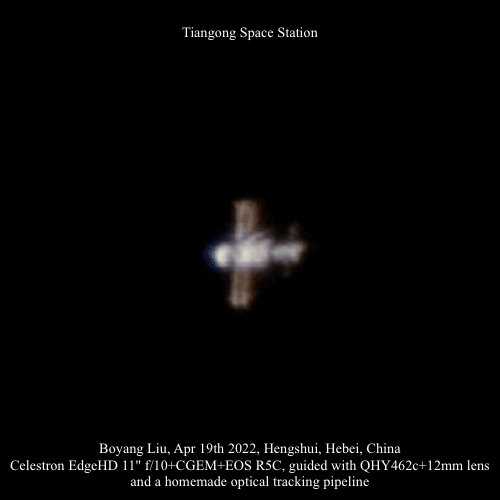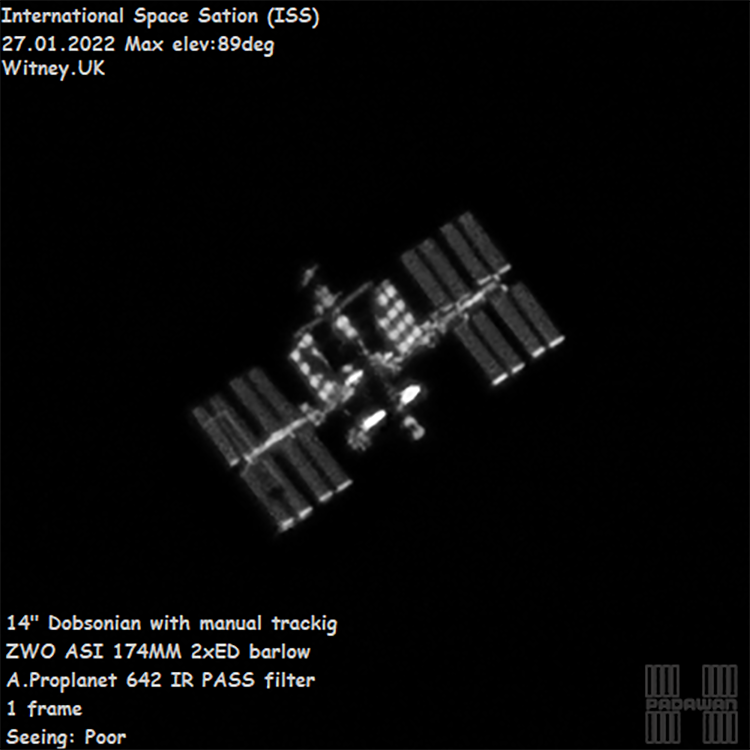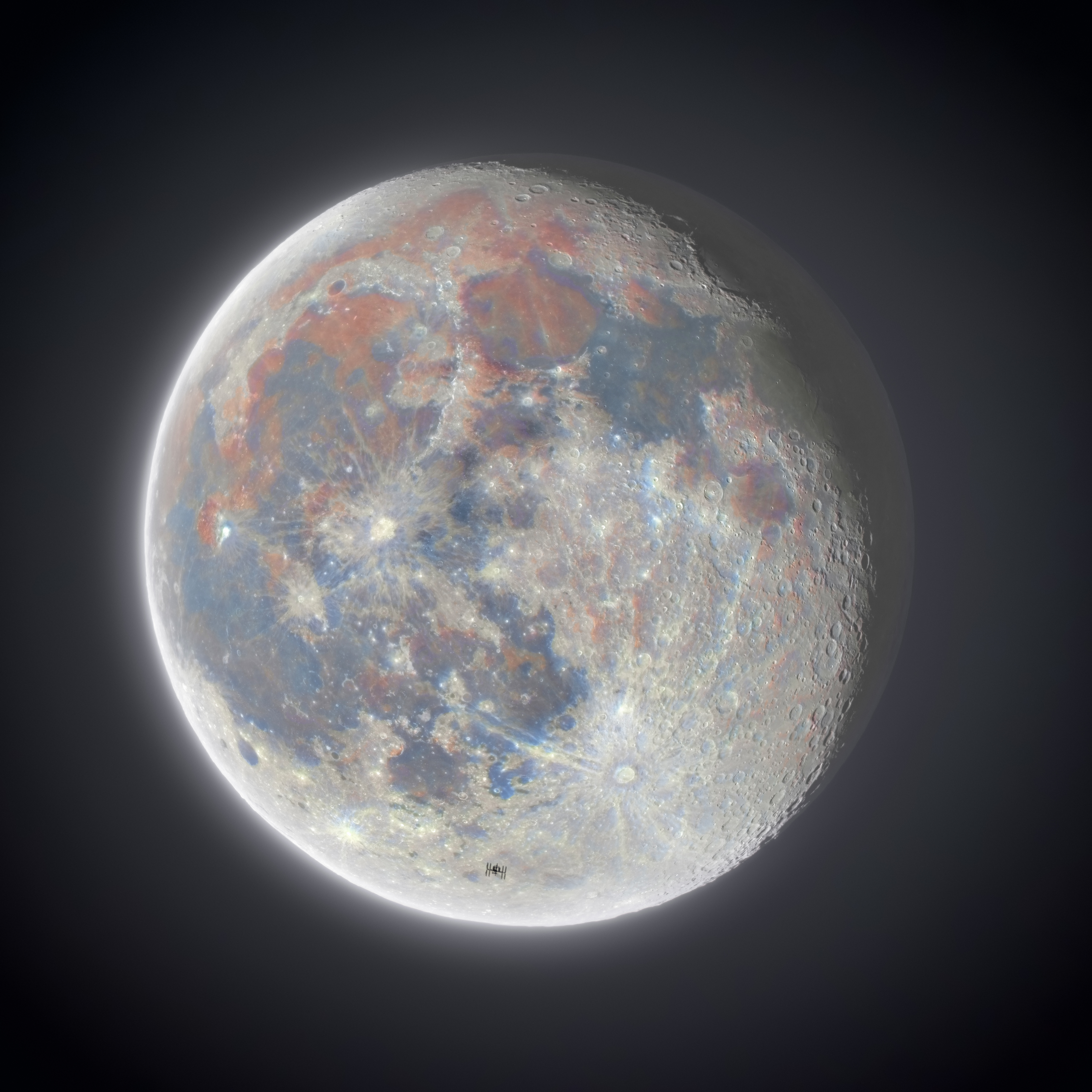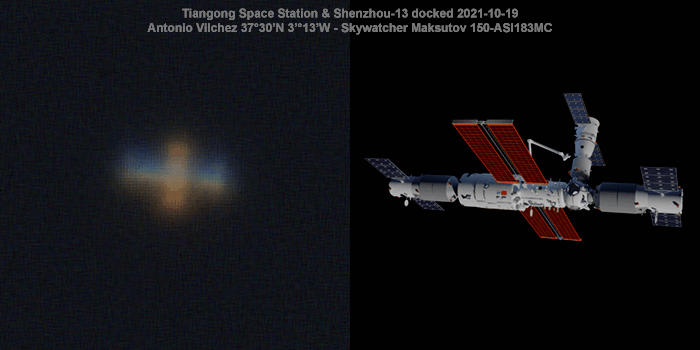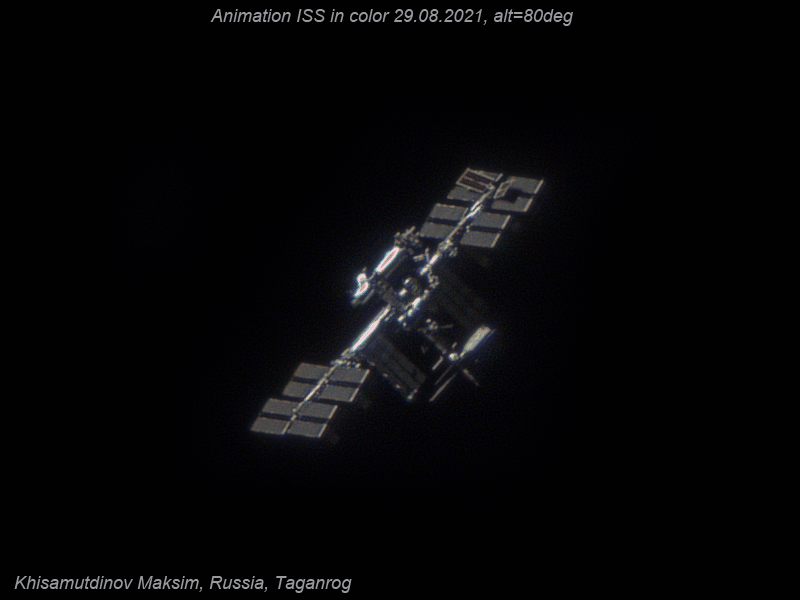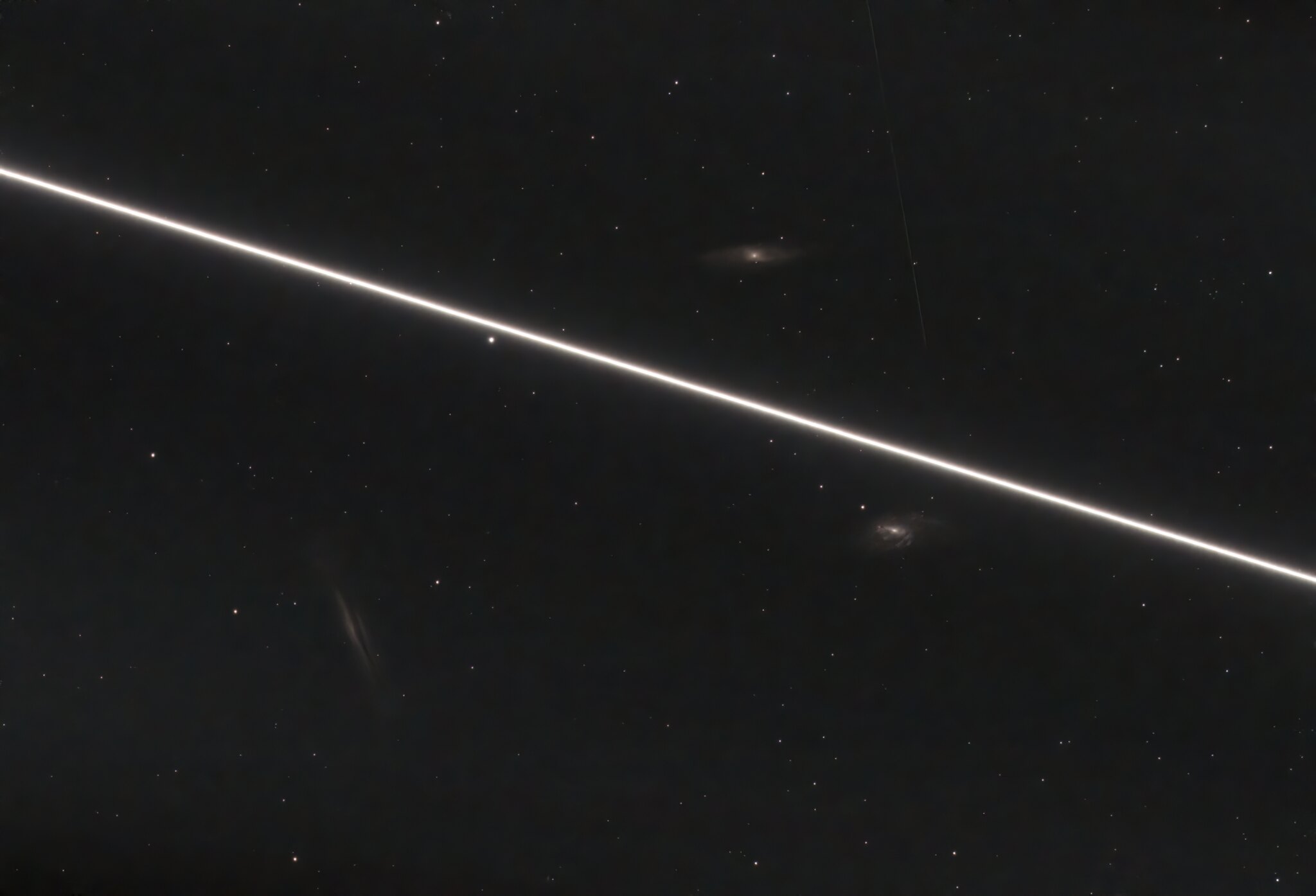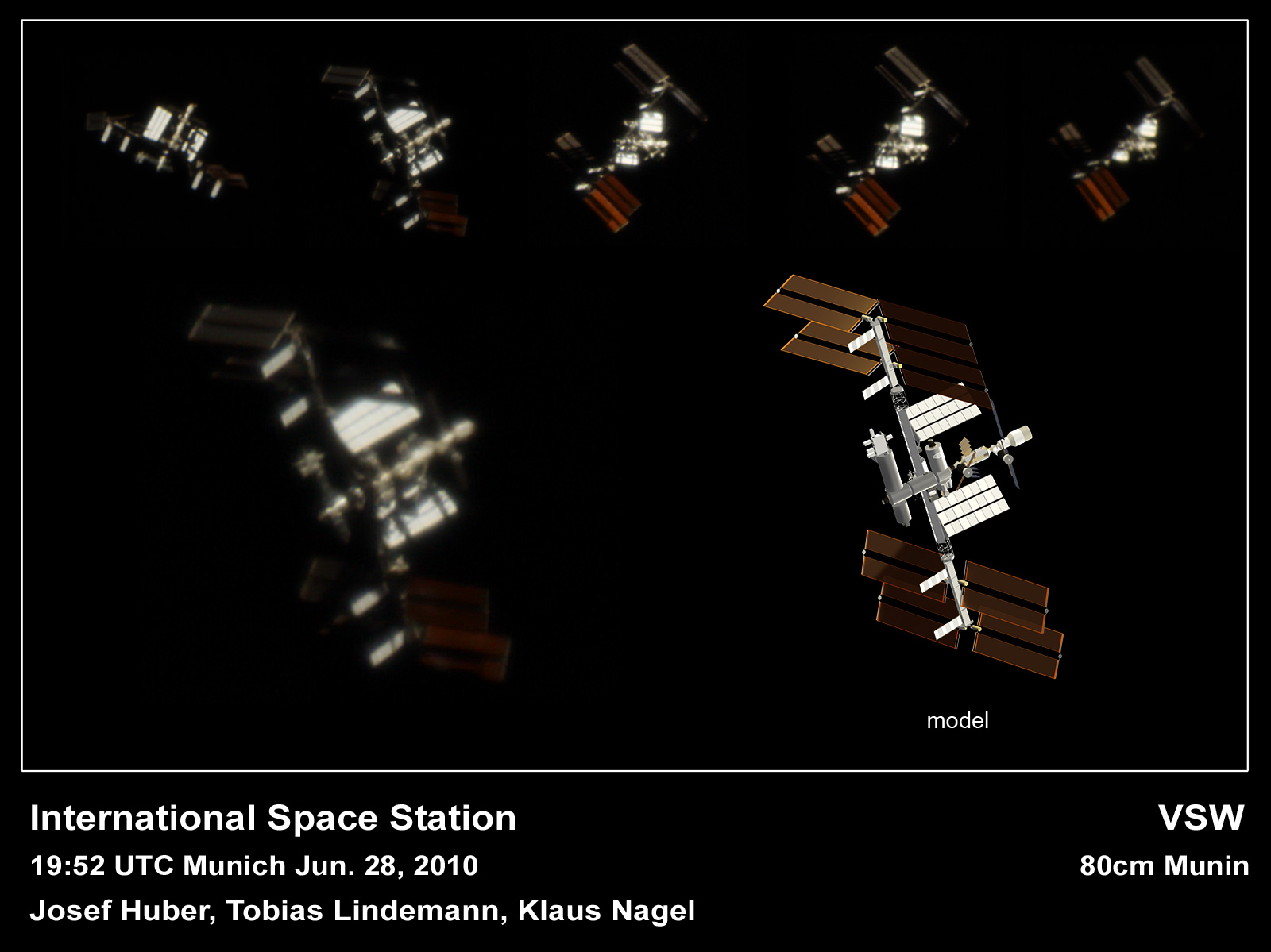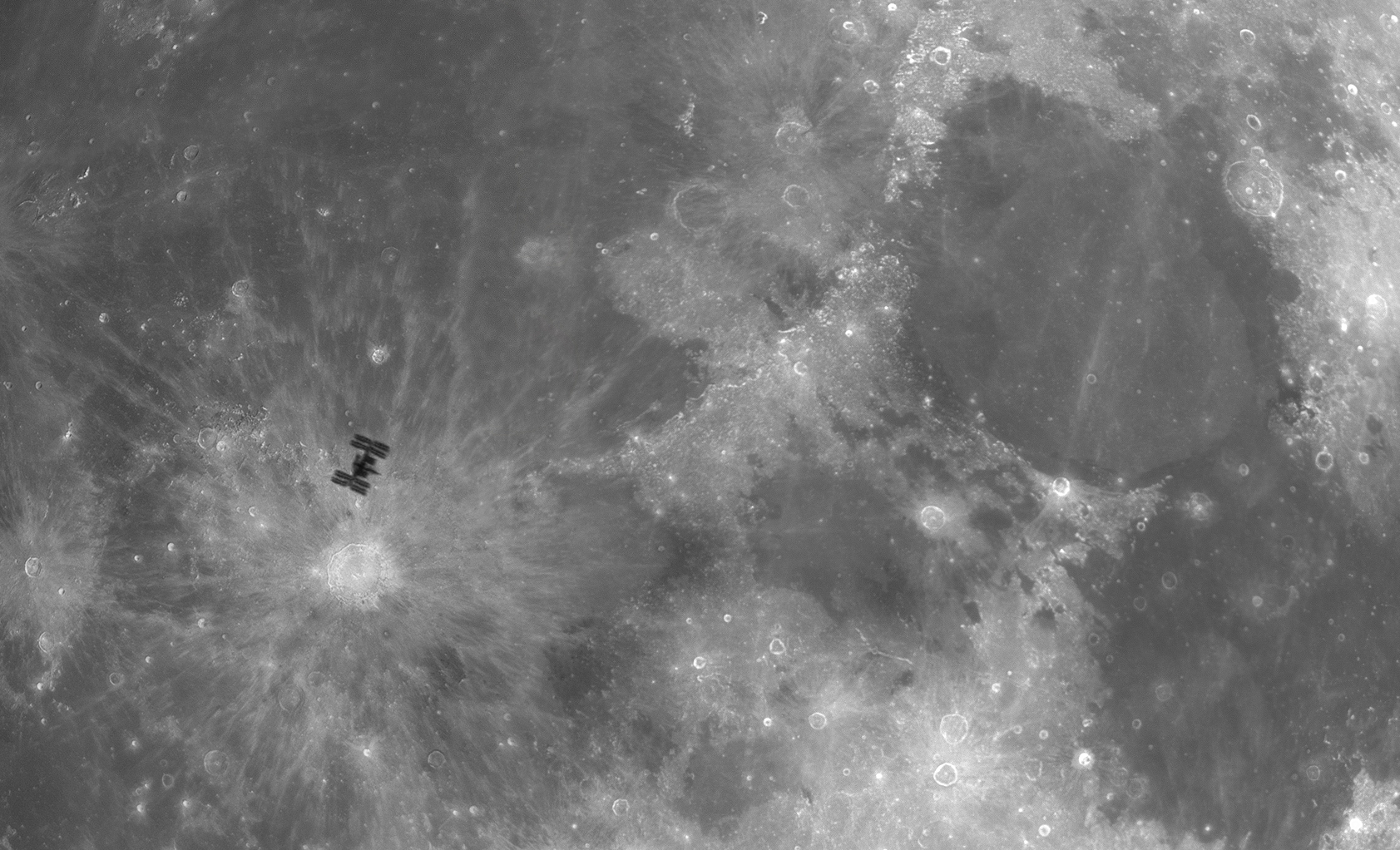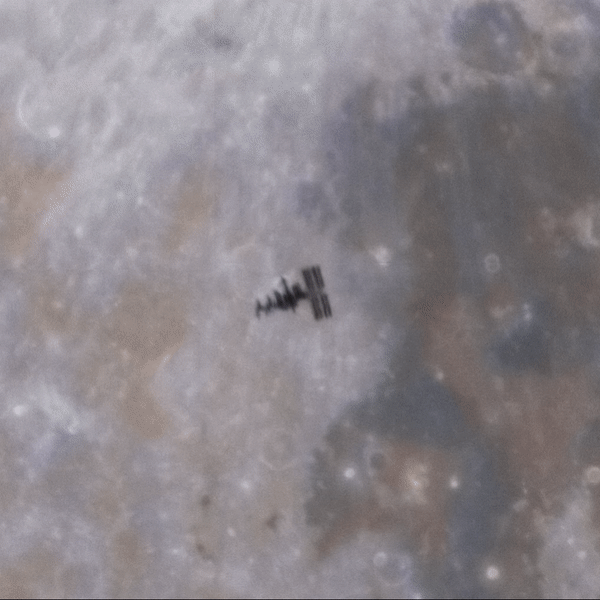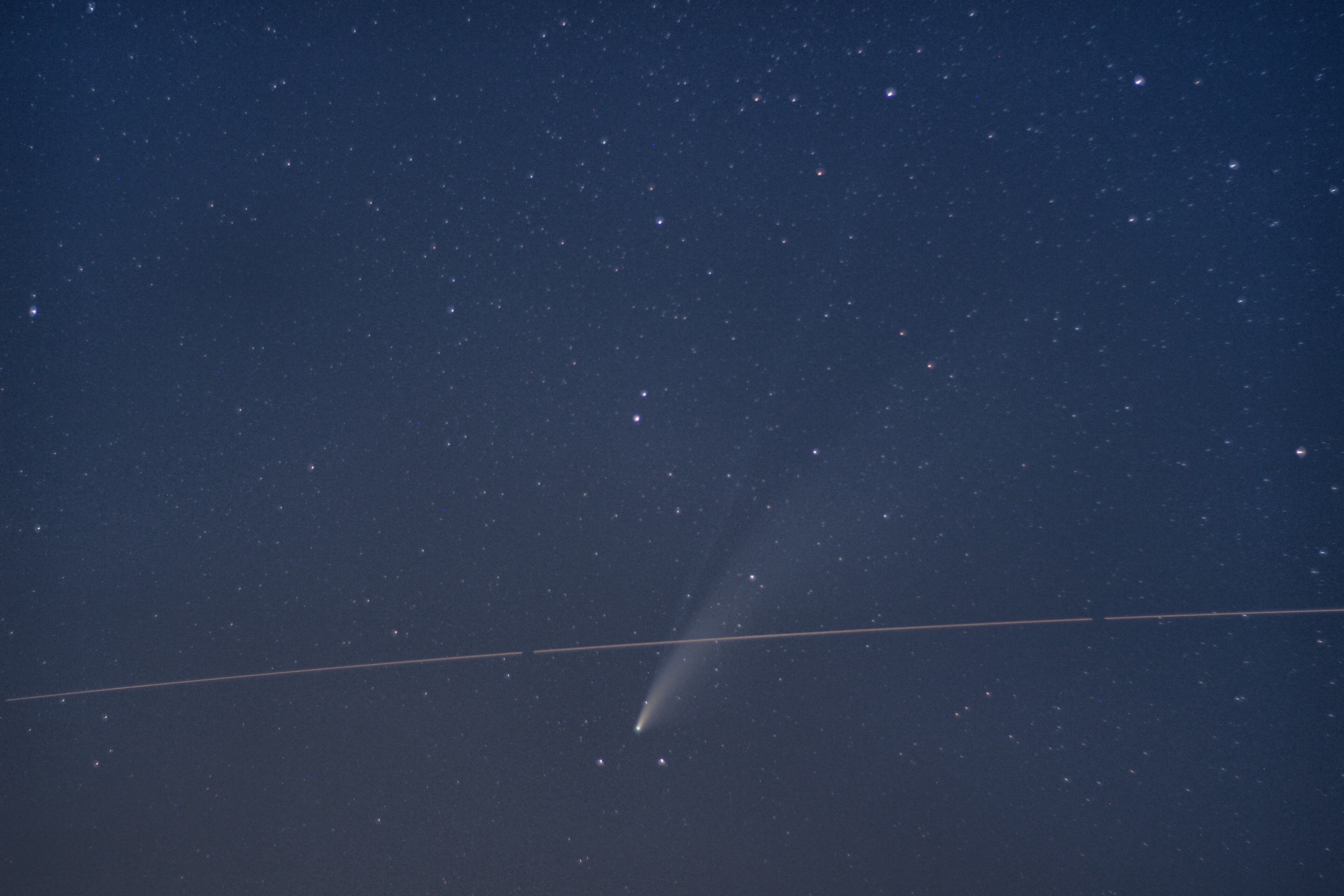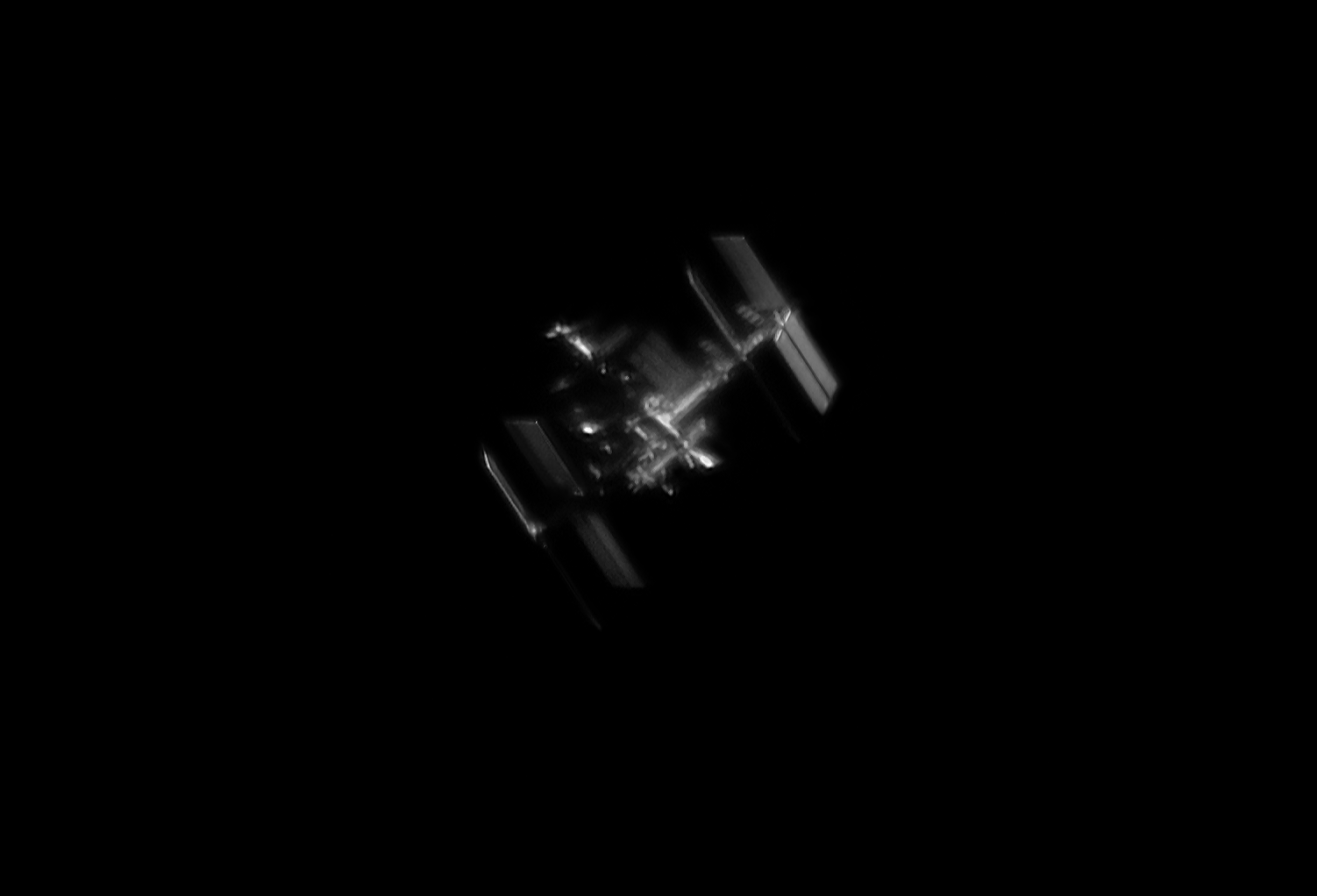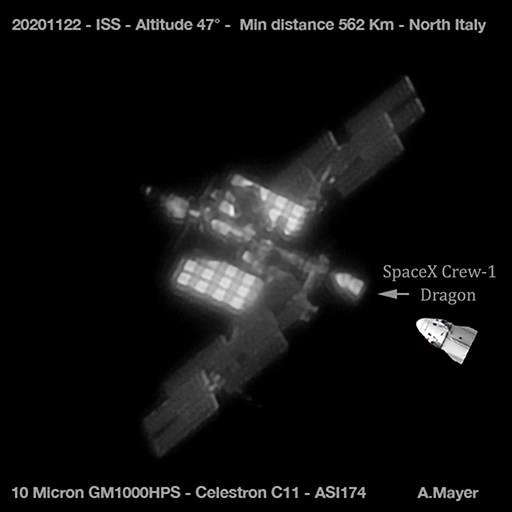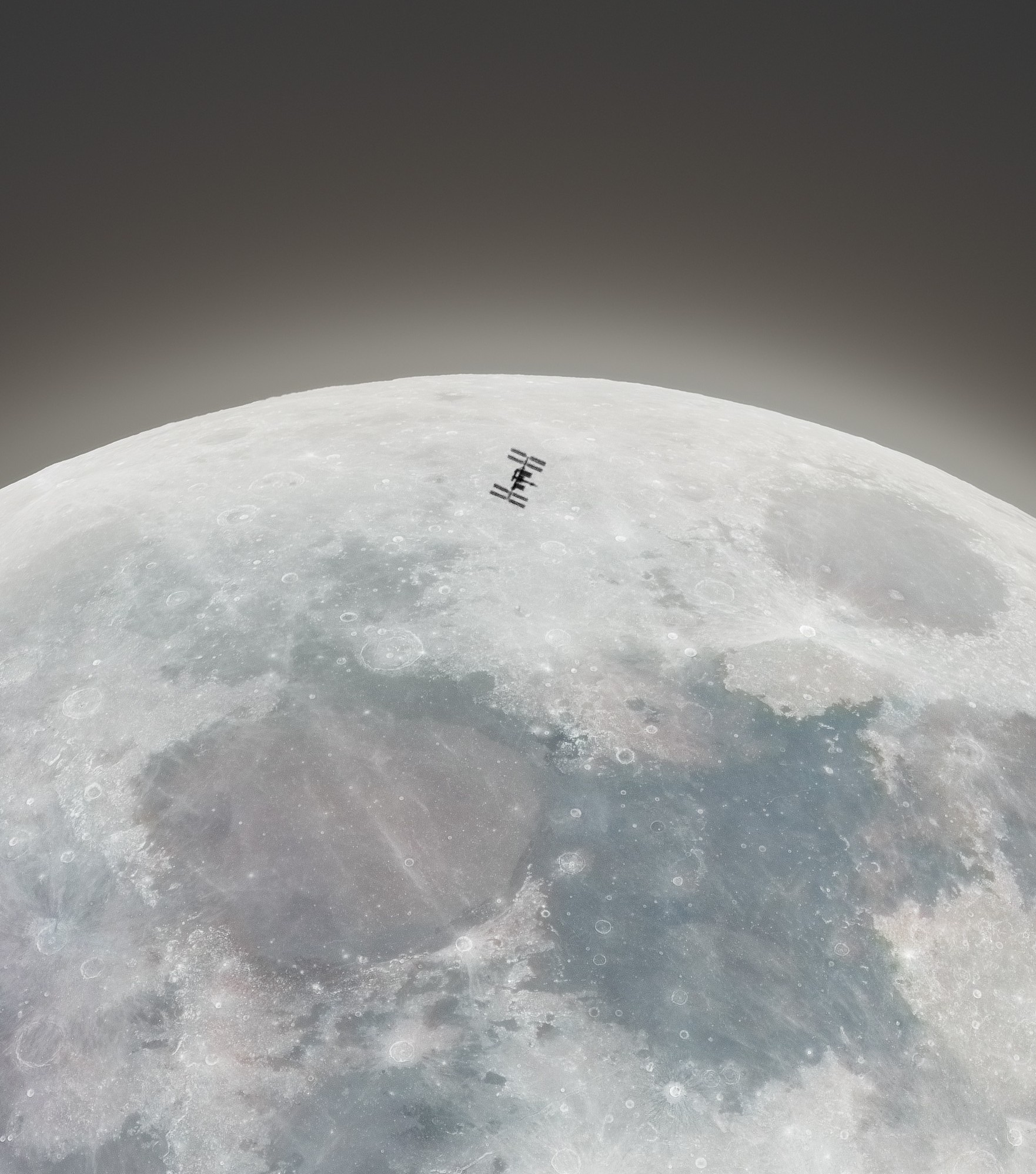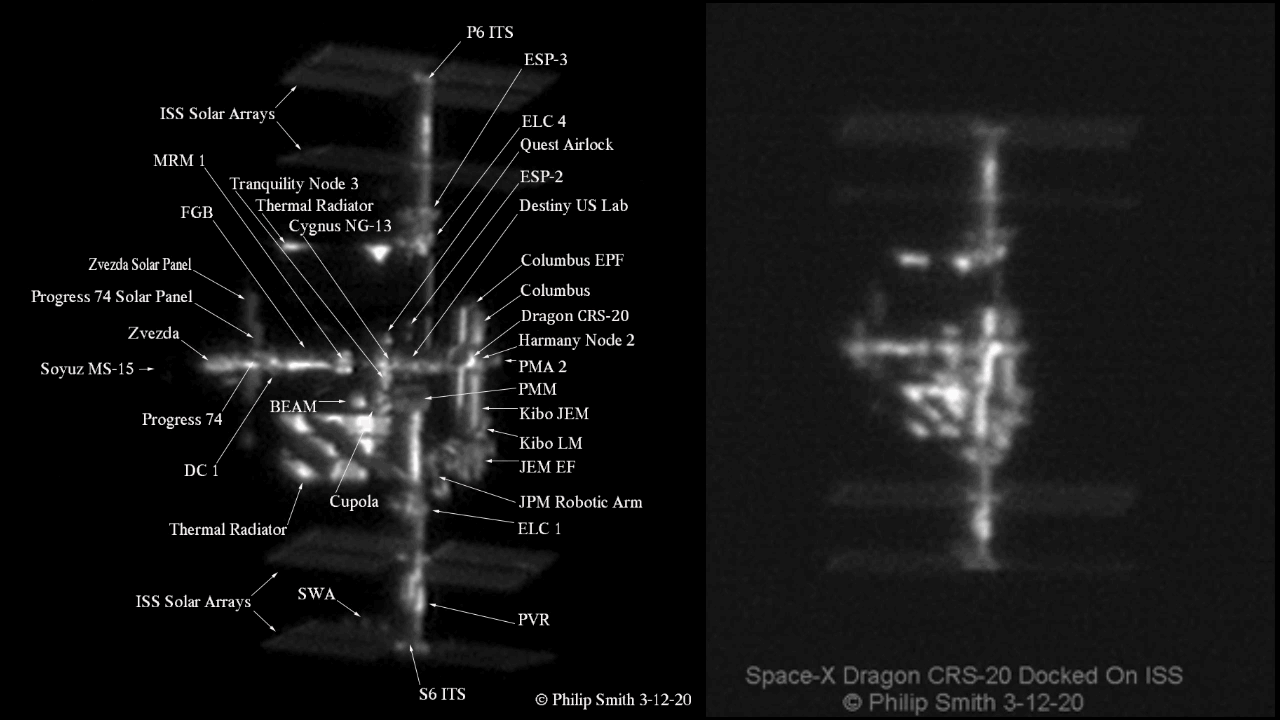Space Station Photo Of the Month
August 2025
Slightly different post!
The other day Charline Giroud discovered something interesting. By her words the following occured:
“On July 10, while I was tracking the ISS in the middle of the night, I noticed on my screen that the station was rotated 180°, but the tracking direction settings remained exactly the same. Usually, the Columbus module, the Harmony node, and the Japanese modules make up the front of the station, but this time, it looked like the Russian segment was leading. The first thing that came to my mind was, “No way, they flipped the ISS upside down!” Then I started questioning everything: “Is that even possible? Did I just mess up my camera settings? If so, why are my adjustment settings still the same?” I shared my unusual data with fellow astronomers, some had no idea what was going on, while others thought I shouldn’t talk about it because it sounded too crazy to be true.
Two days and four ISS passes later, I finally got my answer. The ISS passed very close to Deneb, which served as a fixed point of reference during the pass. The data confirmed, without any doubt, that the ISS was indeed flipped 180°. After sharing my findings on social media, some people responded with documents explaining this flip maneuver and why it’s used. I’m glad I had the opportunity to capture it, especially since I rarely get to image that side of the station, my latitude is too high to see it in the northern part of the sky.”
After Charline shared her post, I dug out some of my own photos. I happened to image ISS, mostly because a Hungarian research astronaut – Tibor Kapu was on the ISS at the time with the Axiom-4 mission. So I tried to do imaging at that period too. This is what I came up with.
I marked the direction of travel which similarly to Charline never changes on my setup too. I always put the camera on the telescope the same way, so that is a good starting point. Based on that ISS was indeed flipped 180°. Remarkable observation by Charline, thank you!
Please make sure to follow Charline’s work on her facebook page!
More of her incredible photos here!
Previous month’s Space Station photos
2025 – January (Charline Giroud), 2025 – February (Charline Giroud), 2025 – March (HEO Space), 2025 – April (Andrew McCarthy), 2025 – May (HEO Space), 2025 – July (Szabolcs Nagy)
2024 – January (Tomonaga Miyazaki), 2024 – February (Rafael Small), 2024 – March (Philip Smith), 2024 – April (Huo Zhuzhang), 2024 – June (Ethan Roberts), 2024 – July (Charline Giroud), August (Huo Zhuzhang), September (Michael Tzukran), November (Tom Williams), December (Philip Smith)
2023 – January (Liu Boyang), 2023 – February (Andrew McCarthy), 2023 – March (Philip Smith), 2023 – April (Laurent Langelez), 2023 – May (Josh Palmer), 2023 – June (István Zoltán Földvári), 2023 – July (Thierry Legault), 2023 – August (Dr. Sebastian Voltmer), 2023 – September (Michael Tzukran), 2023 – October (Andrew McCarthy), 2023 – November (HEO Space), 2023 – December (Astronomy Live)
2022 – January (Dr. Sebastian Voltmer), 2022 – February (Tom Williams), 2022 – March (Gábor Sági), 2022 – April (Dr. Sebastian Voltmer), 2022 – May (Boyang Liu), 2022 – June (Gábor Sági), 2022 – July (Andrew McCarthy), 2022 – August (Boyang Liu), 2022 – September (Tom Williams), 2022 – October (Michael Tzukran), 2022 – November (Philip Smith), 2022 – December (Michael Tzukran)
2021 – January (Michael Tzukran), 2021 – February (Christopher Becke), 2021 – March (Andrew McCarthy), 2021 – April (Sage Grey), 2021 – May (Josef Huber, Klaus Nagel, Tobias Lindemann), 2021 – June (Philip Smith), 2021 – July (Philip Smith), 2021 – August (Mark Cullen), 2021 – September (Maxim Khisamutdinov), 2021 – October (Michael Tzukran), 2021 – November (Antonio Vilchez), 2021 – December (Andrew McCarthy)
2020 – April (Philip Smith), 2020 – May (Andrew McCarthy), 2020 – June (Simon Tang), 2020 – July (György Soponyai), 2020 – August (AMOS telescope), 2020 – September (Tom Gwilym), 2020 – October (Tom Glenn), 2020 – November (unknown), 2020 – December (Alberto Mayer)
(click on names above to jump)
How to Submit your photo to become an IPOM?
If you think you have captured something incredible and International Space Station related, please send it to the following email address: metrolinaszabi@gmail.com
Please make sure your post contains the following:
– time/date the photo/animation was taken (UT)
– equipment
– flyby details (max. elevation, from – to times, brightness – these are optional details, not compulsory though but welcomed)
– write in brief story (if possible, not compulsory though)
July 2025
Not sure if I have ever chosen my own Space Station Guy photo for Space Station Photo of the Month. The exception has not happened due selfish reasons, instead due historic reasons. I have spent almost the entire June in Florida, hoping to see the Axiom-4 mission launch from the Kennedy Space Station Press site. Sadly the various delays prevented me from seeing the launch. It was a shame, because one member of the crew is a fellow Hungarian, Tibor Kapu! Hungary is a tiny country, but we were the 7th nation to send astronaut, well in that time cosmonaut Bertalan Farkas to space almost exactly 45 years ago. Although since then another person with Hungarian roots, Charles Simony paid twice to go to the ISS in 2007 and 2009, Tibor Kapu is the first Hungarian research astronaut to reach the space station.
I have been planning to take images of the ISS whilst Tibor is up there, but I made some changes on my setup last year and I was struggling to make it work. Tracking the station manually with my Skywatcher 250/1200 dobsonian telescope was a regular thing, but I decided to upgrade it, motorize it. Well I’ve spent a good chunk of the summer of 2024 experimenting, then a long break and lots of thinking came and now a few weeks ago, with a fresh mind I restarted my experimenting with motorized tracking. The upgrades made small, but important differences. The first days of July brought me some promising imaging sessions, the mount was doing okay and I had the feeling that success is not that far away now. And on the 3rd of July finally it all came together. Just at the right time!
Equipment details
Skywatcher 250/1200 Flextube Goto telescope
Zwo ASI 224MC colour camera
TeleVue 2.5x Powermate
50mm Guidescope + Delta DLT-Cam for wider view
May 2025
Chinese Space Station from above! I really can’t stop marvelling these unique photographs HEO is taking from low Earth orbit. HEO Space is a company using sensors on satellites in space to image other satellites and space objects. Take a look at their X profile and be amazed of their incredible work!
April 2025
Yesterday afternoon I captured a fleeting moment- the moment the ISS transited the moon. Despite being broad daylight, the ISS was clearly visible against the cratered terrain. I captured it in conjunction with the lunar south pole where astronauts will soon return. The uncropped photo shows just how small the ISS is compared to the moon, despite being 1000x closer. Humans may be small, but our significance is massive.
Shot with a 14″ skywatcher dobsonian and c11, with am apollo-m max on each . The dob had a 2.5x powermate. An r5 with a 1000mm lens was used for color.
Andrew McCarthy’s instagram and twitter account is so worth to follow!
March 2025
For March I choose something unique, a set of images of the International Space Station taken not from the ground, instead from above. HEO Space is a company using sensors on satellites in space to image other satellites and space objects. Take a look at their X profile and be amazed of their incredible work!
On this particular set of photos one can observe the improvement of their imaging capability over the past few years. Simply fantastic!!
February 2025
I’d like to share an incredible shot from Charline Ground! Here is a list of astrophotographers – Ralf Vandebergh, Martin Lewis, Thierry Legault and Sebastian Voltmer. They have one thing in common, namely they all managed to take a photo of an ongoing EVA.. meaning an astronaut outside the International Space Station. And this incredible list just got longer with Charline. Here is what se said about the photo:
The pictures were taken with my C11 Edge HD on an EQ6R-Pro mount, using a 2x Barlow and a 664MC camera.
January 2025
Imaging the International Space Station presents unique challenges due to its highly reflective materials, such as metal and white coating, as well as areas in shadow or partial illumination. These factors create a highly contrasted target, making it difficult to find the right exposure settings. Typically, images of the ISS show both overexposed and underexposed regions within the same frame.
To address this issue, I attempted to capture the ISS in HDR mode, which combines short and long exposures to reveal details in both the brightest and darkest regions. This approach effectively extends the linear dynamic range of the sensor, allowing details that would otherwise be invisible to emerge. While HDR is a common technique in deep-sky imaging, where static targets make the process straightforward, applying it to a fast-moving target like the ISS is far more challenging. Its size and orientation change rapidly, and for the HDR process to work, the short- and long-exposure frames must align perfectly.
Robin’s solution was to create a script that records a .ser file at high speed, alternating the exposure time between short and long every second, without affecting the native frame rate of the camera. He also developed additional scripts necessary for post-processing the data. We’re now collaborating to refine the workflow and make it more user-friendly.“
I’m excited to see the results of my next HDR images of the ISS, and I hope this technique opens up new possibilities for astronomers, especially in planetary imaging.
Equipment: C11 Edge HD, a 3x Barlow, and a ZWO 174MM camera under poor seeing conditions, SkyTrack, SharpCap HRD script
Please make sure to follow Charline’s work on her facebook page!
More of her incredible photos here!
December 2024
I imaged the International Space Station that had a Max Pass of 87° at 5:43 am EST from my Manorville NY Observatory on 10-19-24.
My imaging configuration was:
– Celestron EdgeHD 11 ′′ telescope
– Orion Atlas EQ-G modified mount
– ZWOASI174mm
– Baader Planetarium 2X Barlow Lens
– IR610 1.25″ filter
– MoonLite focuser
Check out Philip’s facebook page for more of his work!
November 2024
Moongrazer
“I captured the International Space Station making a flyby of the Moon this morning! Just days after its close flyby of Jupiter, I was blessed to capture the ISS making *yet another* grazing transit of a solar system body – the Moon this time. Might be time to enter the lottery…
Gorgeous orange hue to the solar arrays this time around, which were being backlit by the rising Sun. SpaceX Crew-9 Dragon is also seen docked to the station.
This is a composite image using ~1 second of data stacked per object (w/ ISS being tracked during the event), and aligned using the guide scope view.“
These are Tom Williams’ own words to accompany his fantastic capture of the ISS. He’s work is plain outstanding, to prove that just simply scroll through Tom’s X or Instagram profiles and be amazed!
Equipment: Skywatcher 400P (16” Dob), Uranus-C at 6300mm f/15.6.
Time/date: 06:46:16.5 UTC, 27.10.2024
September 2024
Michael captured the International Space Station with incredible level of details. This is nothing new from him, the way he captures the ISS is one of the best globally. We could go into details about my favourite element on this photo like the iROSA solar panels or Canadarm 2, the robotic arm that in use to help attaching certain type of cargo spacecraft to the ISS. But this photo is truly unique historically, because of the ill fated Boeing Starliner. It is docked to the forward facing side of Harmony module. It is located on the photo right next to the also incredibly detailed SpaceX Crew Dragon spacecraft, which is the most prominent white feature on this shot.
These spacecrafts are both part of the Commercial Crew Program (CCP) which meant to have two totally different type of spacecrafts in service to ferry astronauts to and from the Space Station. Whilst SpaceX with its Crew Dragon managed to fulfill the requirements successfully (8th ongoing Crew mission, also 4 private missions), Boeing is still struggling big time! This Crewed Flight Test (CFT) was meant to be the final journey to the ISS and back, this time with crew onboard before the certification of the vehicle. Sadly the mission has failed, the two astronauts must stay on the ISS till February as part of Crew-9 mission and the vehicle will come home on the 7th September autonomously without its crew. What the faith of Starliner will be is a huge question mark.
This is why this photo so important and valuable – history is being written right now, sadly in a wrong context.
Make sure you follow Michael’s twitter feed for the latest photographs.
Equipment: Planet Wave 24″ telescope with a Zwo 290mm camera. Satellite locking software.
August 2024
Attempting to shooting the space stations multiple times in daylight in the summer is very difficult: because you can’t predict exactly when there will be clouds, and you have to fight the heat at the same time. In addition to the first ISS tracking in the early morning, one other ISS transit and three CSS trackings were disturbed by high clouds. The two afternoon transits were so badly affected by high clouds that I was still searching for the calibration star and focusing as the CSS rose. In addition, since the transit location was an hour and a half metro ride away, I borrowed a friend’s equipment for the ISS transit shoot and then hoofed it back. The final image of the space stations was stunning!
July 2024
The launch of Boeing’s Starliner spacecraft captured the imagination of many ISS photographers. It’s first journey to the ISS was well documented by amateurs, see details in this video. However the Starliner CFT mission launch happened in a very unfavourable time for imagers, at least not around launch time. But since Starliner was docked to the ISS and Charline Giroud took some amazing DAYTIME images!! She wrote me her thoughts about the past couple of days imaging sessions of hers.
‘In May 2022, I had the opportunity to image the Boeing Starliner passing above Oxford at 84° while it was performing a docking maneuver less than 100 meters from the ISS. In June 2024, the Boeing Starliner was launched as a crewed mission for the first time with two NASA astronauts onboard and docked on the top of the Station on the PMA2 on the Harmony module. The planned 8 day mission was extended due to a malfunction of the Starliner thrusters and a helium leak and it’s still docked on the Station while I’m writing this description on July 6.
The ISS picture shown here was taken in broad daylight using a colour camera. Capturing the ISS in daytime has been my obsession lately but my localisation makes it possible only in summer. At Oxford’s latitude, 51.7°, the ISS can’t be seen in the northern part of the sky but only at the zenith or in the southern direction. This makes daytime tracking very tricky because the sun is usually in the southern direction and makes the ISS backlit. However, around the summer solstice, the sun rises in the northeast, creating a good configuration to illuminate the station and make it visible for tracking.‘
More of her incredible photos here!
June 25: ISS pass at 7:35 (UTC+1), at 87°, the Sun was at 26° above the horizon.
Equipment: Setup: CPC800, 2x barlow, UV/IRcut filter, ASI662MC, SkyTrack, SharpCap
Please make sure to follow Charline’s work on her facebook page!
June 2024
I captured this on the 19th May at around 11:15pm from Canterbury. I used my Celestron C8, ZWO ASI290mm with a Baader red filter for less atmospheric distortion, and manually tracked with my NEQ6. I wasn’t initially intending to photograph the ISS at that time but since I had prepared to photograph the moon and saw it rising above the house, I decided to go for it last minute and results turned out really well. The tracking was not done motorized as I find hand tracking a more reliable method with my current setup.
Please do follow Ethan’s X profile for more of his incredible work
April 2024
– Equipment: Celestron 8″, iOptron AZ Mount Pro, QHY5III678M+IR850 filter.
– Flyby times: 2023/10/16 China Space Station(CSS) 13:07-13:17(UTC+8), 14:44-14:54(UTC+8). Internati
March 2024
Philip Smith
I made this short blink animation from the files I imaged Tiangong Space Station on 10-05-23 from my Manorville NY observatory with a maximum pass of 81°. My imaging configuration was an EdgeHD 11 ′′ telescope with a Baader 610 long-pass 1.25″ Filter on a ZWO ASI174MM (mono) camera and Baader Planetarium Carl Zeiss 2x Barlow Lens in a MoonLite focuser on an Orion Atlas EQ-G modified mount.
Kind Regards To ALL
Still images form this imaging session here. Check out Philip’s facebook page for more of his work!
February 2024
Rafael Small
The composition was inspired by the idea that there are a couple of people out in outer space with a space station, and with that they represent almost all of humanity’s sciences. It was a grandiose experience to see in articles how the space station was built, to see how they work and the traffic there… and it’s all there in the evening, sometimes as a bright “star” in the sky, sometimes in front of some celestial body and we know it from a cake plate to take a photo with carved glass :).
The panorama itself consists of 11 panels, one part of which included the ISS. Because of the Optolong IR pass filter, I had to increase the exposure a little and so I was able to expose the given area with 1.5 milliseconds.
The ISS has moved in, as well as 80fps – so the silhouettes of the space station do not “touch” each other. Of that, the portion is approx. Out of 20 images, I selected the one where the ISS was visible above a brighter area.
The picture was taken with a mono camera, but after the transition I went up to the telescope dome with a Canon EOS6D and with the 401/3250mm SC telescope I also photographed a stack of 10-10 images and then the Moon with normal RGB photos, stacking them together, increasing the color saturation, using them as a color layer the mono moon surface got the color layer.
I wasn’t the only one taking photos in the field! A good friend was also with me, who photographed the full moon and the transit with a 72/432 Evostar and an ASI533MC camera!
Image Details:
Equipment: ZWO ASI290MM, JURA 194/1450, SkyWatcher EQ5GT
Exif data: exp: 1,5ms, gain:110, 11x1000frame 10%
Processing: Firecapture, PIPP, Autostakkert3, Photoshop
Location: Hungary, Zselic Starry Sky Park, Zselic Park of Stars
January 2024
Tomonaga Miyazaki (Tomo)
Date/time: 2023/8/4 11:14:17 JST (2:14:17 GMT)
Location: Kasamatsu, Gifu, JAPAN
Equipment
Telescope : Takahashi Mewlon-250 250mm F1Z
Mount : Takahashi EM-200 Temma2
Camera : Player One Astronomy Apollo-M MINI
Filter : Baader Planetarium ND 3.8
This sunspot was in the AR13386. It was very attractive, so I’ve checked the position of sunspots at home carefully before going out. After I’ve finished preparing my telescopes, a young man nearby told me, “This parking lot will be closing in 30 minutes.” so I hurriedly moved my telescopes, which caused me to break the USB connector and had a difficult time. However, at the moment of transit, the seeing was very good and I was able to take very sharp ISS. Furthermore, this sunspot caused an X1.6 flare 44 hours later, making it a much better memory!
Make sure you follow Tomo’s X account.
December 2023
Occasionally I do include slightly other-than space station photos and this one is going to be one of those! Usually these exceptions are spacecrafts or space hardware (like the Hubble Space Telescope), also satellites too. But this one is absolutely a unique one to me as well. What if I say this is not a spacecraft, but part of a once intact spacecraft/rocket? Namely a Starship!
So this photo was taken by Scott Ferguson. He runs a youtube channel called Astronomy Live, he is a regular ISS and rocket videographer. I have met him in person in the summer of 2022 in Florida and we watched together with the hungarian Spacejunkie Team an Atlas V launch which by the way was my very first rocket launch ever!
The background of this photo is simply staggering, I really would call it once in a lifetime event! I will let him explain what happened, these are his words:
“Here’s the story for the photo. I used an 11″ Celestron NexStar GPS telescope and Blackmagic Pocket Cinema 4K camera to track Starship as it rose from Islamorada in the Florida Keys. This was tracked using my open source RocketTraker software with a trajectory prediction file from FlightClub.io so that it would follow the expected position of Starship in the sky. I knew it was going to be a long shot as to whether I would even be able to spot Starship against the blue daytime sky on the video viewfinder camera, which is essentially just a security camera mounted on top of the telescope to help center on objects that I’m tracking. When I spotted the Starship explosion from the FTS system on my viewfinder camera, I quickly moved the telescope to get it centered on the vehicle. I found the top section of Starship tumbling and spewing residual fuel and tracked it until my telescope could no longer keep up.”
Watch his footage here and also follow either his youtube channel or his X account!
November 2023
This section is usually about mindbending amateur space station photos, but every now and then I give way to exceptionally amazing professional photographs too. For this month I brought you not one, but two photos from a pretty interesting point of view. These photos were taken by HEO Space, a company which conducts on-demand non Earth imagery. I found them on X and some of their shots really blew my mind. Mainly because these images were taken from above the International Space Station ISS and the Chinese Space Station (CSS). Also they provided amazing renders too, so everyone can see what we supposed to see from these space stations. Do check out HEO’s X profile, they also shared images about the Hubble Space Telescope and the new Starlink generation 2 satellite, not even mentioning the incredible ISS shots.
Okey us amateurs can’t really compete with these shots, that’s true. But seeing our beloved space stations from above is pretty damn cool, right?
October 2023
I am absolutely honored to feature this incredible photo composite from Andrew McCarthy! Is is unique and outstanding in so many ways, just to look at it gives me chills!
Andrew McCarthy wrote:
“I’m thrilled to share the most science-fiction looking shot I’ve ever captured: here’s the International Space Station against the backdrop of Oceanus Procellarum on the moon. I’m absolutely obsessed with how this one turned out.
The full photo has all the detail you would expect from one of my moon images, but the presence of the ISS making it truly unique. I spent the last week making sure this image would look flawless in print, which you can pick up on my website this weekend only.”
Date/time: 2023/09/07
Location: Casa Grande, Arizona
Equipment: Celestron C11 SCT scope with ASI174mm, also 14” Skywatcher goto dobson telescope with a TeleVue 2.5x powermate with ASI662mc
Andrew McCarthy’s instagram and twitter account is so worth to follow!
September 2023
For this month I chose something unique – this time a satellite photograph from Michael Tzukran. Before his shot there was no ground based photo existing of SpaceX’s new generation v2.0 Starlink satellite. The level of details is simply breathtaking! Huge change in the Starlink satellite structure and size. The v2.0 satellites are much larger and they have not one, but two solar panels.
Starlink constellation from SpaceX remains a huge conversation starter among astronomers and everyday people. On one side SpaceX is offering unique internet services to its customers all around the globe. On the other hand they obstruct visual and radio astronomy which might have unpredictable consequences for humankind.
Tell us what you think about internet constellations below in the comment section!
Make sure you follow Michael’s twitter feed for the latest photographs.
Equipment: Planet Wave 24″ telescope with a Zwo 290mm camera. Satellite locking software.
August 2023
“International Space Station captured from my backyard. For this ISS shot I used an effective focal length of 2800mm
Sebastian Voltmer is one of the most inspirational astronomer and ISS photographer I know of. On this photo you can see a lovely flare on one of the newly installed iROSA solar arrays. These solar arrays are meant to extend the capabilities of the ISS, supplying more power for experiments conducted on board.
He is super dedicated and the imagery he shares on his Instagram account is truly mesmerising. Make sure you will check out Sebastian’s incredible work on his website www.voltmer.photo, also you will find him on Twitter and on Instagram as well.
Date: July 10, 2023 Telescope: C11 EdgeHD Camera: QHY 5-III-462 C Mount: GM2000 HPS
July 2023
Always a pleasure to feature photos from the bests in this field. Please welcome Thierry Legault on Space Station Guys website. This is the very first time I can present Thierry’s mindbending work in International Space Station imaging and I am deeply honored to have the opportunity. Hopefully more of his work will make its way to this space on internet in various categories like ISS Transits.
Make sure you follow Thierry Legault’s work on his website and on Twitter,
Now let’s see what Thierry said about this incredible shot, which was taken during an EVA or as commonly known a spacewalk:
June 2023
Astrosketching was the imaging technique in the past. All of the first astronomical observation of Moon and planets has been done by astrosketching. Basically one person sits by the telescope and draws whatever object can be seen in the eyepiece. There are still some amateur astronomers who does this old fashioned method. A of my friend from Hungary – István Zoltán Földvári has been telling me, that one day he will observe the International Space Station. Eventually he did and here is the result of his amazing observation.
“For the first time in my life, I was able to observe the ISS through my telescope, which was a fantastic experience! Tracking it wasn’t easy. I saw certain segments of the station, I think maybe the radiators.”
Check out István’s youtube channel to see some of his amazing Moon sketches.
May 2023
Another incredible ISS photo, this time around from Josh Palmer. I do remember, when he was getting started with ISS photography and he came a long way since. His images and animation of the International Space Station is truly magnificent! This is his explanation of the imaging session, during which he managed to snap this great photo.
“This was captured so long ago, so I don’t remember many of the details besides what I have included in the image description below. I have been using my 16” dob for a while now, and the Skywatcher/SynScan Satellite Tracking app works very well. Unlike my C11 telescope, I don’t have the ability to automatically center with the guide cam, but my new setup makes it very simple to adjust the centering in real time. After capturing the raw video, I use PIPP to center and crop the SER file, then export to TIF format using SER player. Using Lightroom, I group and filter the images before stacking. Photoshop is then used to finish for presentation. Capturing the ISS remains my favorite form of astrophotography, and I look forward to every opportunity to see it!
International Space Station, 11/16/2022. Captured with Orion Skyquest XX16g, ASI174MM, 3x Explore Scientific Focal Extender, Baader 610nm filter, and Firecapture. Processed with PIPP, Autostakkert!3, Registax, Photoshop, and Topaz Denoise 6. Tracked with Synscan Pro Satellite Tracker. Stack of 30 frames. The maximum height was 84° and seeing was Excellent.”
Make sure you follow Josh Palmer’s facebook account!
April 2023
What an incredible photo by Laurent Langelez! He managed to capture the International Space Station and the approaching Crew Dragon spacecraft at a very close proximity. Everyone who ever tried to capture anything similar might know, how difficult it can be to capture anything remotely similar.
Make sure you follow Laurent’s website!
Meade 300mm, EQ6 mount, Zwo ASI 174 camera and barlow lens (magnification to be determined around the 9m focal length), Baader 610nm filter
At 70° of elevation.
March 2023
This amazing composition taken by Philip Smith shows both of the currently existing space stations on orbit around Earth. On the right side there is the International Space Station, and next to it on the left the Chinese Space Station. Through Philip’s photos we get a good idea about how large they relative are to each other.
‘I put my CSS and ISS into this one image to share with you. This is the setup and information for each of them. 1st the CSS > History was made with 6 Chinese astronauts now onboard Tiangong. I had the rare opportunity to record this HISTORY over my home. I imaged the Chinese Space Station ( Tiangong ) on 12-02-22 Max 80° 5:55pm EST in average seeing conditions from my Manorville NY Observatory.
My imaging configuration was an Edge HD 14″ telescope with and Red Chroma 1.25″ filter on a ZWO ASI174MM camera and Baader 2x Barlow Lens. All on a modified Orion Atlas EQ-G mount setup in Alt-Az configuration. 2nd ISS > I also imaged the SpaceX Crew-3 Endurance, docked to the International Space Station at 8:33pm EST on 04-02-22, from my Manorville, NY USA backyard observatory. The pass was at max 84° but, the full sky had a thin layer of clouds.
This image is a stack of 50 frames from my recording. My imaging configuration was an Edge HD 14 ′′ telescope with and Baader Red 610 nm Longpass 1.25″ filter on a ZWO ASI290MM (mono) camera No barlow, all in a MoonLite focuser on a Atilius Orion EQ-G mount modified.’
Check out Philip’s facebook page for more of his work!
February 2023
Andrew McCarthy is not a stranger to this website. He keeps on taking our breath away with his incredible International Space Station (ISS) transit shots. This time around the ISS was travelling (transiting) our celestial neighbour. These are Andrew’s words about the event:
“I captured an incredibly difficult shot: ISS transiting the moon, while gently kissing Tycho crater as it flies by at 5 miles per second. That crater is 53 miles wide, so while the station almost looks like it’s orbiting the moon it’s actually 1000x closer to us. The field of view of capture was quite narrow, so the rest of the moon was assembled as a mosaic. That creates a super detailed image without sacrificing the composition.
There will be a print available on my website, check the link in my bio (cosmicbackground.io) if interested.”
Date/time: 2023/01/04 at 23:08 MST
Location: Florence Arizona
Equipment: C11/asi174mm & Sony a7II
Andrew McCarthy’s instagram and twitter account is so worth to follow!
January 2023
December 2022
Here is an amazing photo from Michael Tzukran. Not the first time I am sharing his work, but this time I bring your a photo he took on the 2nd December 2022 from Tel Aviv during BROAD DAYLIGHT with that beautiful Planet Wave 24″ telescope and an IR camera. This is one of his first shots during daytime and definitely more to follow.
To not miss his work, make sure you follow Michael’s twitter feed for the latest photographs.
November 2022
China’s Wentian lab module was moved to the “side port of the space station’s node cabin,” on 30. 09. 2022. The Tiangong space station is now in an L shape as a result. I imaged the Chinese Space Station (Tiangong) in a new configuration on 11. 10. 2022. image far right. I imaged the center image of CSS (Tiangong ) on 19. 09. 2022. before Wentian moved and docked to the space station’s node cabin. I imaged the far left image of Tianhe-1 is the “Core Module” also known as (“Harmony of the Heavens”)
Images were in 2021-2022 by Philip Smith. Check out Philip’s facebook page for more of his work!
October 2022
This incredible photo of the one and only International Space Station was taken by Michael Tzukran from Tel Aviv, Israel. Michael is an important figure at Tel Aviv University, he and the team assembled there an amazing 24″ telescope with a purpose of purely imaging satellites including the ISS. This photo is one of the first ones since the installation of the scope finished. The prospect of this observatory regarding satellite imaging is huge. Many more photos will follow in the future. Make sure you follow Michael’s twitter feed for the latest photographs.
September 2022
Tom Williams is one of those ISS photographers who already has been in this section of Space Station Guys website. His work is truly amazing and this time I will bring you a unique animation from him. Check out Tom’s twitter profile and be amazed!
This is daytime ISS! Let’s see the details of his capture.
– 35% of 500 raw frames stacked per frame of animation in a kind of moving average. I.e frame number 100-600, 200-700, 300-800 etc. (Animation). Then the best of the stills was separately processed for the single image.
August 2022
Animation was taken by Boyang Liu. Look up more of his work on his twitter account. These are his words about how he took these incredible photos:
Celestron CGEM+EdgeHD 11″, Canon EOS R5C
Guided with QHY5III178m+12mm lens and a homemade TLE+optical tracking pipeline
July 2022
“I deprived myself of sleep last night to chase this ridiculous shot down- the sunlit international space station transiting the last quarter moon.
It sailed past Eratosthenes, Copernicus, Kepler, and was on its way to Aristarchus when I captured this moment. My camera was shooting at 155fps during the pass. It was only in the frame of view of the camera for about a quarter of a second.
There will be a print available on my website for a short time, check the link in my bio (cosmicbackground.io) if interested.”
Date/time: 6/21 at 5:15am MST
Location: Florence Arizona
Equipment: C11/asi174mm & Sony a7II
Andrew McCarthy’s instagram and twitter account is so worth to follow!
June 2022
Amateur photographers from the United Kingdom were incredibly lucky this May. The Boeing Starliner OFT-2 mission kept us all at the edge of our seats since this was a repeat of the not so perfect OFT-1 mission. From the UK we were gifted with clear sky and good flyby opportunities of the International Space Station – which meant good opportunity for the Boeing Starliner as well. We saw Starliner approaching the ISS, we photographed it REALLY close to the station and also when it was docked to it.
This incredible animation was taken by Gábor Sági from Oxford on 20th May 2022. The new Starliner spacecraft is only approximately 200 meters away from the ISS! I can’t emphasize enough how rare an opportunity like this really is. The ISS flyby times should be convenient, just like the timing of the approach, the position of the spacecraft relative to the station, the season (now we’re in High Beta Angle season when ISS constantly illuminated by the Sun) and of course the sky should be clear. So many totally individual factors must align for a photo opportunity such as this one.
Check out a video summary of all the great photos and videos of the event I know of on this youtube link.
Equipment used for this imaging session: 14″ Dob with manual tracking, ZWO ASI 174MM mono camera with A.P 642 IR PASS filter, 3x Barlow lens
Location: Oxford, United Kingdom
May 2022
For May I choose this incredible animation from China, taken by Boyang Liu. Look up more of his work on his twitter account. These are his words about how he took these incredible photos:
“I started thinking about tracking the space stations from 2020, but all previous attempts using existing softwares found online end up with failure. On March 18th 2022, I finally decided to code my own Python script to do this. The first method I tried was to use TLE predicted speed assisted with manual correction but soon found it unreliable after my first failed test. I switched to the second method, optical detection and tracking, on Day 3 and was able to track a moving bright spot on Day 5. Then it took me 12 more days (4 more failed tests) to get my first succesful shot of the ISS. Then I waited another 2 weeks for the next passing of the Tiangong (Chinese Space Station). The first reachable passing was on April 19th 2022, when I drove 3 hours from Beijing to Hengshui to get a closer look. The attempt was successful, I had more than 2 minutes’ stable tracking with tracking error < 5 arcmin for most time, as shown in the attached diagram. I stratigically altered the pointing of the polar axis to avoid the meridian flip and achieve an optimised y-axis tracking precision. This strategy allowed the optimal recording of the closest part during the passing.
In this animation, we can clearly identify the robotic arm parking along the Tianhe Core Module. We can also identify that the Tianzhou cargo ship is connected to the back portal of the Core Module. This changed 2 days later when I had my second shot of the Tiangong: the Tianhe Core Module switched direction and the Tianzhou cargo ship was connected to the front portal of the Core Module on April 21st.
Equipment: Celestron CGEM+EdgeHD 11″, Canon EOS R5C. Guided with QHY5III462c+12mm lens and a homemade optical tracking pipeline
Date and time: April 19th 2022 at ~5:00a.m. (UTC+8)
Location: Hengshui, Hebei, China (37.66144N, 115.67719E)
Settings and processing: Cropped to Super 35mm (5.9K), recorded with Raw ST at 60fps, ISO 3200, 1/1400s. Each consecutive 450 frames were grouped together into AutoStakkert!3, 50% best frames were stacked. Minor adjustments with Lightroom.”
April 2022
Spacewalkers Imaged From The Ground
This incredible photo was taken by Dr. Sebastian Voltmer german astronomer. Make sure you will check out Sebastian’s incredible work on his website www.voltmer.photo, also you will find him on Twitter and on Instagram as well.
“During the spacewalk of the two astronauts Raja Chari and Matthias Maurer the International Space Station appeared shortly after sunset in the bright evening sky over Germany.
This image of the ISS pass was taken on March 23, 2022 under good seeing conditions through my C11 EdgeHD telescope from the hometown of ESA astronaut Dr. Matthias Maurer. The docked SpaceX Dragon capsule, with which the astronauts of Crew-3 flew to the ISS, is clearly visible.
Three years ago I got to know Matthias Maurer at our SpaceStudio Weltraum-Atelier in Nohfelden, Germany which is located near to Matthias‘ hometown.
Additional fun fact: I produced the song for his ISS mission, “Cosmic Kiss”
For the local press in Germany, I first published an initial photo highlighting where Matthias Maurer appeared on the ISS. Due to my time constraints, I released this version right away on the internet, which then went viral, while I continued to work on the final image version with both highlighted astronauts.
Already two days after the spacewalk happened, Philip Smith contacted me. He is a world well-known photographer of all things ISS and has been published in many forms of media. Philip Smith with his ISS obsession, noticed on my picture that NASA astronaut Raja Chari is also detectable – on the robot arm “Canadarm2” – and he created a wonderful combination picture shown here with an insert from the NASA livestream. I feel like I just made a once in a life time historic image. It’s probably the first ground based image showing two spacewalkers on the ISS at the same time.”
March 2022
This incredible photo of the International Space Station was taken from Oxford, UK by Gábor Sági amateur astrophotographer. With his 14″ dobsonian telescope he managed to take approximately 3000 frames and only this one turned out to be good. But I mean very GOOD!
Please find equipment details on the photo. Also please make sure you follow his work on Twitter, totally worth doing so!
February 2022
This is a fantastic animation of the International Space Station passing in front of the Aristarchus crater, which is actually overlapped by the ISS, really cool shot! It was taken by Tom Williams astrophotographer. Make sure you will check out Tom’s fantastic work on his instagram and twitter accounts.
20% of 5,000 frames (lunar detail) with a single frame of the ISS super-imposed.
Transit settings: 0.129ms & 155 gain, 1936×1096 @ 136fps. I almost missed the transit due to orbital element inaccuracies (both transit-finder.com & Stellarium have been wrong for multiple observers).
Equipment: Skywatcher 400P GOTO (16″ Dob), ZWO ASI462mc, Baader RG610 longpass. Native 1800mm f/4.4. ISS size was around 50″ at 63° altitude.
January 2022
“Cosmic Kiss | When the International Space Station ISS with our astronaut Matthias Maurer on board passes the current New Year’s comet Leonard, there is – as in this “long” exposed image – a trail crossing the comet.”
This fantastic photo was taken by Dr. Sebastian Voltmer german astronomer from La Palma. Make sure you will check out Sebastian’s incredible work on his website www.voltmer.photo, also you will find him on Twitter and on Instagram as well.
December 2021
Photo taken by Andrew McCarthy. “By positioning myself at just the right point on Earth and just the right time, I can capture the silhoutte of the International Space Station against the bright sunlit moon. These fleeting events last only moments, and in this case the ISS was only within the frame of my camera for 1/25th of a second.
This image is one of the clearest transit pictures I’ve captured so far, with the ISS captured at a whopping 2800mm for extreme detail. The final image was created as a mosaic, by stitching together the rest of the moon to the frame that included the ISS, making a crystal clear portrait of that moment.”
Andrew McCarthy’s instagram and twitter account is so worth to follow!
November 2021
This fantastic animation of the Chinese Space Station (CSS) was taken by Antonio Vilchez. Apart from the great quality of the footage it is worth noting the unusual orientation of the station. It is approaching to the observer sideways – this is most likely a slight rotation caused by the Shenzhou-13 which was docking to CSS shortly before this footage was recorded! The rotation is most likely corrected since and all went back to normal on the Chinese Space Station.
Please make sure to follow Antonio on his twitter, astrobin and facebook profiles.
October 2021
This is not the first time I choose Michael Tzukran’s work as ISS photo of the month, but this is the first time I share something I think an extremely unique result even among ISS photographers. The level of details on this photos is really outstanding. I could start naming the incredible features like the Super Draco thrusters on the CRS-23 (since undocked) cargo spacecraft, or the BEAM expandable habitat, the newly docked Nauka module etc. I recommend you to take your time to take a good look at this ground based photograph and marvel, how far photography got in the past decades!
Michael’s equipment: custom fork mount on 16 sct” camera 174mm. Location: Tel-Aviv, Israel Date: 14.09.2021
If you like Michael’s work, make sure you follow him on his Instagram and/or Twitter profiles.
September 2021
High resolution International Space Station animation in colour – Maxim Khisamutdinov
Animation ISS in color 29.08.2021 04:46:00 GMT, altitude ~80 degrees, 29 frames.
Mount eq8 evilmode v3. seeing 3/5, transparency 5/5 (1-bad, 5-excellent). Celestron C14 XLT (~4 meters-direct focus) + GSO 2 ” focuser + Baader IR-cut + asi462mc. 160fps 600×400, mono12, gain 250 (overdone), shutter speed 0.8 ms. Adding 30% of 280 frames in AS!3 with wavelets, 100%.
Make sure you visit Maxim’s Astronbin picture gallery
August 2021
International Space Station streaks through Leo Triplet taken by Mark Cullen.
The photo was taken with a 132 FLT refractor, ASI 294 camera, single exposure. I really love this composition, it must have taken some planning ahead! Unique, because the brightness of the International Space Station make it the third brightest object in night the sky after Moon and Venus. The galaxies though are very faint objects and to photograph them one needs an equipment capable of tracking the night sky to be able to take long exposure photographs.
Make sure you check out Mark’s Twitter and Flickr accounts!
July 2021
Usually I try not to choose photos in consecutive months from the same photographer, but Philip captured something new and exciting a few days ago. In his words:
“I imaged on 06-30-21 at 6:44am EST in a max ISS pass of 82° the “ISS Roll-Out Solar Array (iROSA)” The imaging all took place from my backyard observatory in Manorville NY, USA. After looking over my recorded ISS video, I was very happy to see I just imaged a new part of the new history of the ISS solar panel system. My imaging configuration was the same for both Space Station images. It was an Edge HD 14 ′′ telescope with an Baader Red 610 nm Longpass Filter 1.25″ on a ZWO ASI174MM (mono) camera at full sensorI 1936 x 1216 and Baader Planetarium Carl Zeiss 1-1/4″ 2x Barlow Lens.
The Roll Out Solar Array(ROSA) and its larger version ISS Roll Out Solar Array (iROSA) are lightweight, flexible power sources designed by NASA to be deployed and used in space. This new type of solar array provides much more energy than traditional solar arrays at much less mass.
NASA astronaut Shane Kimbrough and French astronaut Thomas Pesquet with the European Space Agency (ESA) completed a six-hour and 45-minute spacewalk on Friday (June 25), during which they install the second of six new International Space Station (ISS) Roll-Out Solar Arrays (iROSA). The pair previously worked together during spacewalks on June 16 and June 20 to deploy the first new array.
Friday’s extravehicular activity (EVA) positioned the second iROSA opposite the first on the far left (port) side of the space station’s backbone truss. Now both the 2B and 4B power channels on the port 6 (P6) truss have the new arrays deployed”
Check out Philip’s facebook page for more of his work!
June 2021
All images were from my backyard observatory in Manorville NY, USA.This is a composite image of the International Space Station that I imaged on 05-06-21 and the Chinese Space Station Tianhe-1 Core Module that I imaged on 05-19-21. Please Note: My imaging configuration was the same for both Space Station images. My imaging configuration was an Edge HD 14 ′′ telescope with an Baader Red 610 nm Longpass Filter 1.25″ on a ZWO ASI174MM (mono) camera at full sensorI 1936 x 1216 and Baader Planetarium Carl Zeiss 1-1/4″ 2x Barlow Lens. This is to scale and would look like if the two Space Stations were flying side by side. I think I am the first amature astronomer to get these high resolution images of the Chinese Space Station to make this composite image. The International Space Station and Chinese Space Station were imaged at the same height. I hope in time to get even better images to share. For know I have truly documented history with my images and for the space community.
Check out Philip’s facebook page for more of his work!
May 2021
These photos were take by 3 gentlemen from Germany in 2010! The incredible quality of this photo is just staggering, let’s remember digital photograpy was only taking off at that time. I am extremely happy to have these photos on this website (find more in Guest photos section here).
April 2021
58″ transit on November 10th, 2019. Transit duration across the whole moon was 0.57s. The surface of the Moon is stacked. Equipment: Celestron NexStar 8SE, Orion Atlas EQ-G, ZWO ASI224MC, ZWO ASI183MM-Pro, Baader 610nm Near-IR Filter.
Make sure you go and check out Sage’s website, also his instagram profile too.
March 2021
The ISS winked at me this morning!
At 2:44am this morning, I positioned myself so the ISS would pass between the moon and I so I could get this shot. What I didn’t expect was for the ISS to look so different than usual. Turns out, half the arrays are at an angle in prep for an EVA, so I got a cool, rare shot of a mission happening over our heads! And to top it off, right over my favourite lunar crater. What a world.
I have a write-up of how this shot (and other ISS shots) are planned for and captured on my patreon if you’re curious. They take a fair amount of preparation but anybody can do them! I also shared two videos from this transit so you can see how it looked in real time.
EdgeHD800, Zwo ASI178mm, colour capture afterwards with a Sony A7ii, Hobym traveler mount
Andrew McCarthy’s instagram and twitter account, also you can purchase Andrew’s photos here
February 2021
I knew I had several opportunities to catch the ISS in the vicinity of comet NEOWISE, but this night presented a very close pass right through the tail. When I saw I would have clear skies, I headed out to my favorite spot at the middle of a dam with relatively low light pollution and clear views to pearls the horizon. I would say I packed up my equipment, but it had already been in my car for the past week of comet chasing! The SkySafari Pro app allowed me to properly frame the comet in anticipation of the ISS pass. Arriving at the dam, I aligned the sky tracker and mounted the camera. After several test shots, I just set my remote shutter to take continuous 30 second exposures. This is a composite of three photos taken at 2:05 a.m. UTC Sunday, July 19 2020 (10:05 p.m. EDT local). I used a Canon T5i (crop frame) DSLR with a Yongnuo 50mm f/1.8 lens mounted on an iOptron SkyTracker. Each photo was 30 seconds at ISO 400. Check out Christopher’s twitter account.
January 2021
International Space Station with Resilience Crew Dragon and CRS-21 cargo spacecrafts by Michael Tzukran
Location: israel – Tel Aviv University, elevation: 73º
I choose this incredible photo for January, because this is most likely one of the best quality photos of the International Space Station with not one, but two SpaceX spacecrafts docked to ISS. This configuration has never happened before!
SpaceX is achieving huge milestones now with their new Dragon-2 spacecrafts for both human and cargo flights. On the center bottom of the Space Station one can observe the Perseverance Crew Dragon spacecraft (vehicle for Crew-1 mission docked to forward docking port of Harmony module). But slightly left from Perseverance also the CRS-21 mission spacecraft can be seen (docked to zenith docking port of Harmony module).
Incredible!
December 2021
Our community has been extremely excited about the launch of Crew-1 mission and the Resilience Crew Dragon spacecraft. Many of us is trying to capture the International Space Station with this historic spacecraft (see all the amateur photos of Demo-1, Demo-2 and Crew-1 mission here). But the details Alberto Mayer has captured lately is something unusual, only a handful of people has the right equipment, the perseverance and the dedication to capture something like this. These are Alberto’s words:
“First processing of today’s ISS video shoot with the SpaceX Crew-1 Dragon docked. The 47° passage wasn’t very close. ISS was in fact 562 km away exactly like the distance between Busto Arsizio in Latina but seeing conditions were good so the result was unexpected. I hope I can improve with a second process.
Update: friend Philip Smith informs me that solar panels are no longer deployed so the image has been updated.“
Equipment details on the photo!
November 2021
This photo of the very young International Space Station was taken allegedly in 2001. I sadly don’t know any details about the photo, who took it with what equipment (if you happen to know the origin of the photo, please contact me).
We celebrated the 20th anniversary of continuous human presence on board the ISS. What an achievement!!
October 2021
I tracked the transit line for days leading up to the event, as the path width was approximately 90m according to Calsky. The ground track was moving by several hundred meters at a time, even in the final 24 hours leading up to the event. So, I had to scout several locations and then make my best guess of where to set up and hope for the best. The final chosen location was on a grass field in a park northeast of San Diego. Despite setting up directly on the predicted centerline, you can see from my composite image that the exact centerline would have been perhaps a few dozen meters away, which is reflective of the error associated with the predictions. The ISS was already high above the horizon when it exited Earth’s shadow about 40s before the transit. It started out very dim as it caught the sun, and then quickly progressed to approximately magnitude -4 (brighter than Mars at mag -2) before the transit. I started recording raw video at t-minus 30s to transit, and then watched by naked eye as the ISS increased in brightness as it streamed directly towards Mars. Just before “impact”, I looked at my computer monitor, and saw it flash by, within <1s accuracy of the predicted time. It was an incredible feeling!
Date and time: September 14, 2020 at 05:15:47 (PDT) Location: Northeast of San Diego (approx. GPS 32.9112N, -117.0816W) Altitude of ISS above horizon: 49 degrees Magnitude ISS: -4 Telescope: C9.25 Edge HD Focal length: 2350 (f/10) Camera: ASI183mm (no filter) Shutter speed: 0.35ms Gain: 300 (66%) Camera ROI: 5496×1500 pixels Frame rate: 41fps Mount: CGEM Seeing conditions: average Transparency: Poor from the CA wildfires Software: Firecapture for recording and PIPP for extracting frames
Processing: Individual frames presented with minimal processing, only a levels adjustment (white and black points) and slight tone curve in Photoshop, very slight denoise. The composite is made by overlaying individual frames using “lighten” blend mode. No image stacking was done. Only individual exposures are presented (with composite as described). The YouTube video is made using the raw video converted into a format that can be opened and edited in iMovie, and so represents the original video data.
More of Tom’s work at his Flickr page, also on his Instagram and Twitter profiles.
September 2020
For September’s ISS photo of the month I choose something unique. This photo shows the space station at a very early stage of its life when it was still under construction. This photo was taken in 2002! Also Space Shuttle Atlantis was docked which makes this shot even more unique.
Find more close up photographs of the International Space Station here.
Find more of Tom’s work on his older website and his current website.
August 2020
For August I have something unusual for you!
This page has become home for some of the best amateur International Space Station photos in the world. This time around I will make an exception and will feature something we don’t get to see very often, a professional photograph of the ISS. This incredible photo was taken from Maui Optical and Supercomputing Site (AMOS) with a large 1.6m telescope. Sadly I don’t have more details about the equipment.
The level of details are quite remarkable. Please take a couple of minutes to lose yourself in this photograph. We don’t see the entire station itself, all solar panels are out of the camera’s field of view, just like the russian Zvezda module. The Crew Dragon vehicle shows some fine details on the trunk like its fins, even the IDA (International Docking Adapter) is clearly visible which the Dragon is docked to.
Also the expandable BEAM modul is lovely, next to it the Cupola with some of the windows open. Also the Quest Airlock is incredible. I just love this photo, we only able to see this level of astonishing details when a russian spacecraft comes around and showing the ISS though its external camera.
July 2020
This picture is the result of a 33-hour-long photo experiment I had been planning for more than two years. Besides analemmas and solar eclipses, whole-day-long Little Planets were always on the top of my photo wish-list. The air was very humid and partially cloudy. From 10:00 pm to 04:30 I took the startrails but I was not satisfied seeing the result. From sunrise to sunset I took photos of the Solar disk every 20 minutes. By the afternoon my shoulder and back became completely sunburnt (this year I forgot bringing sunscreen instead of the spare batteries :).
After sunset I started recording the startrails again with red lights of observing lamps of fellow amateur astronomers in the foreground. Before midnight International Space Station flew through the Northern sky — it’s visible on the photo too. In the morning of third day I retook some solar disk photos as the first ones of the previous days had been slightly underexposed and my photo experiment was completed after 33 hours.
2016.07.28-30. Tarján, Hungary Canon EOS 5D Mark II + Sigma EF 8/4.0
More of György’s work at Flickr profile.
June 2020
Skywatcher Esprit 150 Skywatcher EQ8 Rh Pro Lunt 2″ Solar Wedge (Herschel Wedge) ZWO ASI174MM 27.04.2020 Palmdale, California.
More of Simon’s work on his Instagram profile.
May 2020
Here’s a my image of an ISS transit last night. This was taken at 11:59:12PM in my backyard in Elk Grove, California. ISS Angular Size: 59.78″ Moon Phase: 96.9% Waxing Gibbous Transit Duration: .47s This was captured using a reduced EdgeHD 800 with an ASI1600mm running at unity gain at .6ms which captured the ISS along with the luminance data (2000 frames of R), then 100 frames in each R,G,and B filters to draw out the colour.
The ISS was captured in 6 frames out of 2000, which were separated, stacked, sharpened, and overlaid back onto one of the areas captured in the pass, which was overlaid with a LUM layer created by taking the rest of the 2000 frames of the moon in the red channel. The moon wouldn’t quite fit in the field of view, so the full size image is a 2 panel mosaic.
More of Andrew’s work on his instagram profile.
April 2020
The SpaceX Dragon CRS-20 cargo spacecraft was captured with the International Space Station’s robotic Canadarm2 by NASA astronaut Jessica Meir, with Andrew Morgan of NASA acting as a backup, on 9 March 2020 at 10:25 UTC (06:25 EDT). The CRS-20 Dragon spacecraft was launched by a SpaceX Falcon 9 rocket from Space Launch Complex 40 (SLC-40) at Cape Canaveral Air Force Station, Florida, on 7 March 2020 at 04:50 UTC (6 March, at 23:50 EST).
I imaged the SpaceX Dragon CRS-20 cargo spacecraft from my backyard Manorville NY, USA backyard. The telescope was an Edge HD 14″ with an Astrodon Red filter on a ZWO ASI174 mono camera and 1.6 barlow lens. The ISS and SpaceX Dragon CRS-20 passed time was at 6:47am EST at Max Pass 84°. The sky clear 20 minutes before imaging. Then it happened…. Fast moving low fog like clouds covered the sky at the time of the ISS Pass. The ISS brightness was at -3.9 and the Sun was at -15.3° below the horizon. Funny think happened. I could see the ISS in the clouds. The clouds made for a diffuse light like filter on the ISS. I had a little GOD help I would like to think.
More of Philip’s work on his facebook page and also on twitter.
